
The capital of Bavaria - the city of Munich, is rich in attractions, among which: historical and elegant buildings, former residences of monarchs, churches, parks and squares, an abundance of museums and just interesting and beautiful places.
On Christmas and New Year's Eve, Munich's Christmas markets are one of the most visited and busiest places in the city.
In autumn, from the second half of September to the beginning of October, Munich hosts the world-famous autumn festival (beer festival) - Oktoberfest.
All this makes Munich a popular tourist destination, which is pleasant to visit at any time of the year, regardless of the season.
This article contains the most complete list of sights, museums, significant objects and interesting places in Munich. If you want to know only about the most important sights and main museums of the city, where you should go first, or if you have only 1-3 days on Munich, then you can see the list of top attractions and museums here →
The Old Town of Munich (Altstadt München) is a part and historical center of Munich, which contains within its borders the most significant sights of the city.
There are also many cafes and restaurants, shops and boutiques within the old town of Munich, as well as pedestrian streets, squares, museums and accommodation facilities.
The main attractions of the old town include:
- central square of the city - Marienplatz, on which are the Old and New Town Halls, the column of Mary and the "Fish Fountain".
At the top of the town hall tower of the neo-Gothic New Town Hall (Neues Rathaus) is an observation deck, giving a 360-degree view of Munich.
The old Town hall (Altes Rathaus) dates back to the 14th century and originated in part from the old Munich city fortifications, which were converted into a 56-meter-high town hall tower. The Toy Museum (Spielzeugmuseum) is located on the four floors of the town hall tower);
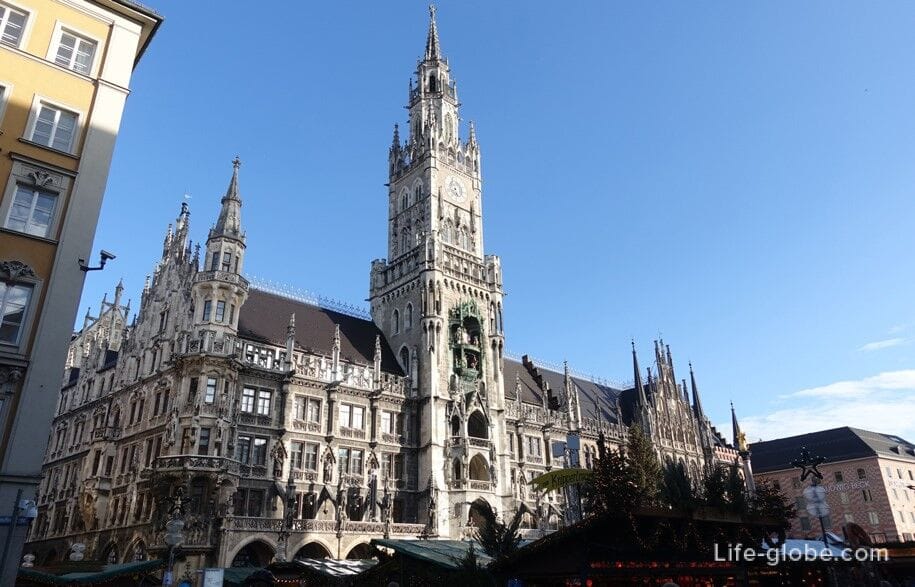
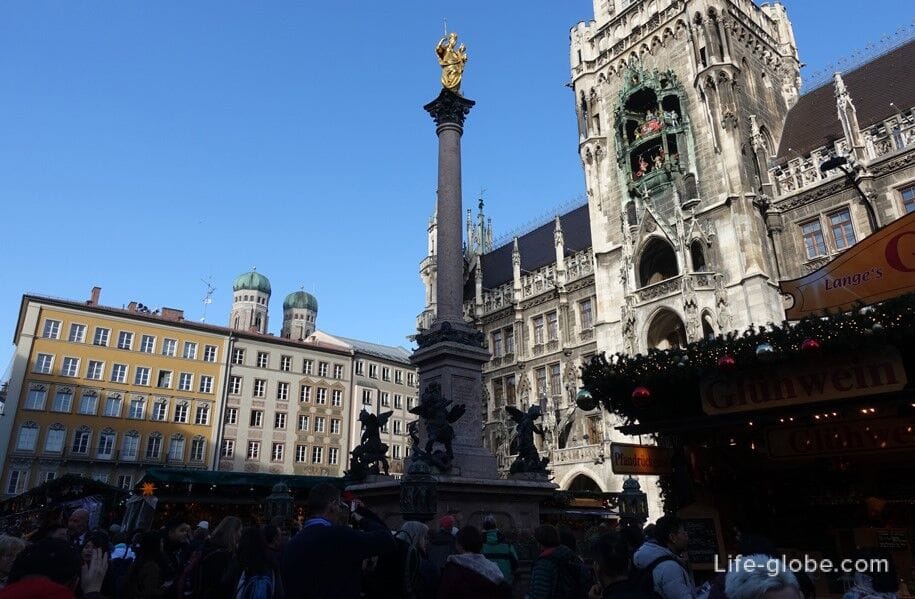
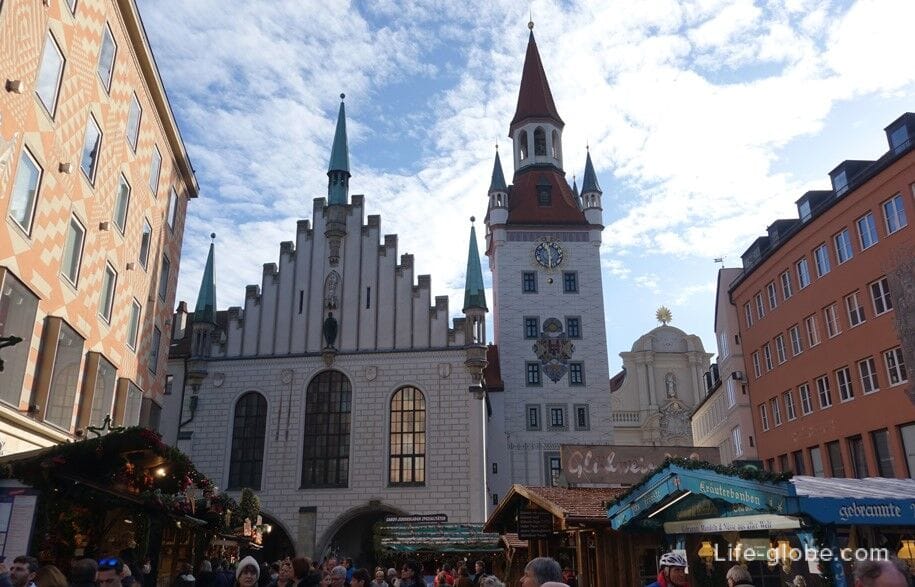
- Old courtyard (Alter Hof) - a former ducal castle and the first imperial residence of the rulers of Bavaria, dating back to the 12th century.
In 1255, Alter Hof became the seat of Ludwig II, Duke of Bavaria. Later, under Ludwig IV, the castle became a permanent imperial residence and remained so until the 15th century.
Today, the Old Courtyard is publicly accessible and is a complex of buildings with a courtyard;

- The Munich Residence (Münchner Residenz), which was a luxurious palace and a full-fledged residence of the rulers, and today is one of the most important art museums in Europe.
The residence includes: 10 courtyards, the residence museum, the treasury, the Munich State Coin Collection, the Cuvillier Theater, the library, the court Church of All Saints, and the Bavarian Academy of Sciences.
Address: Residence street, 1 (Residenzstraße). Website: residenz-muenchen;
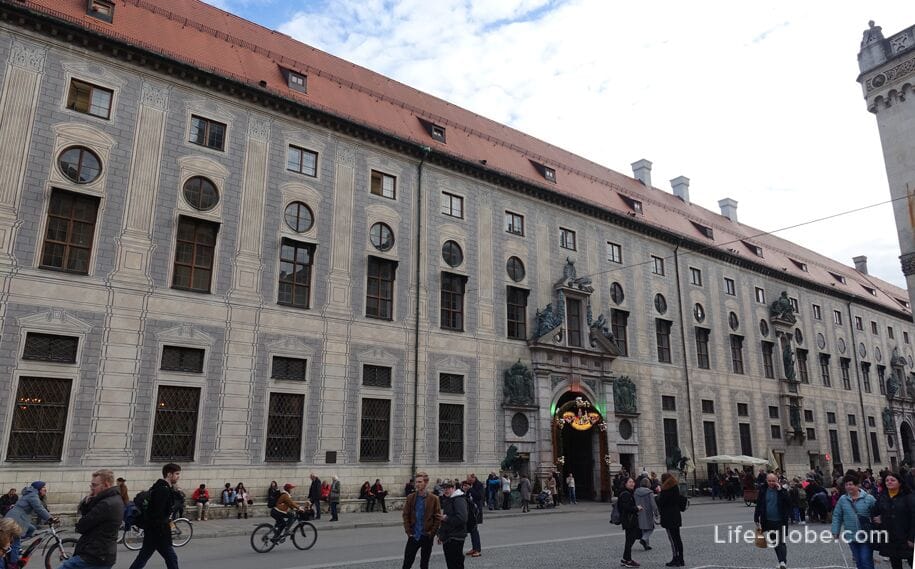
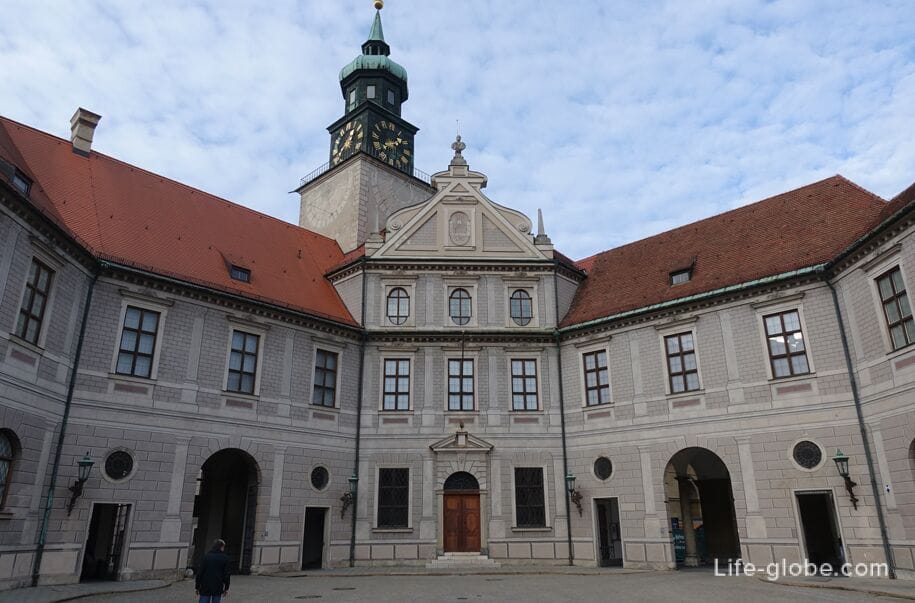
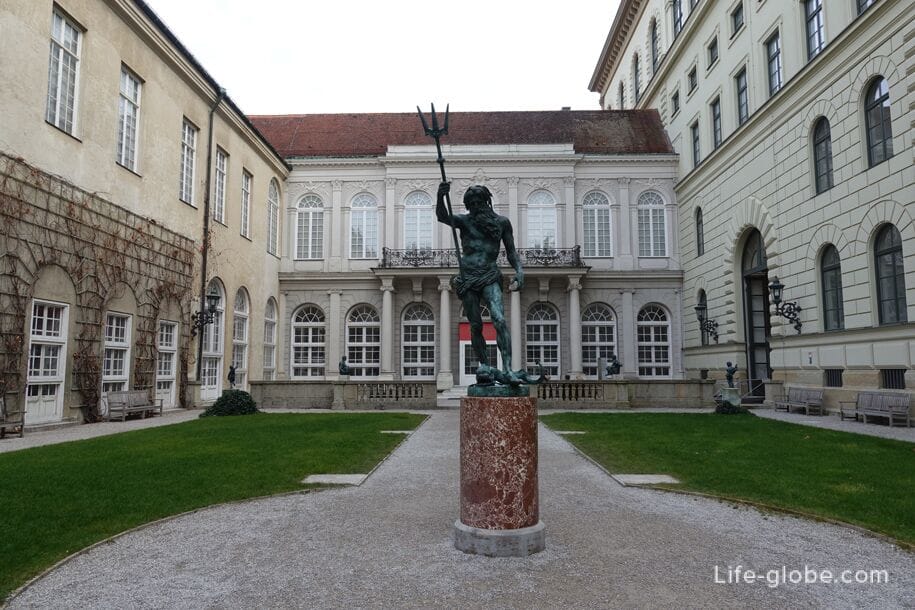
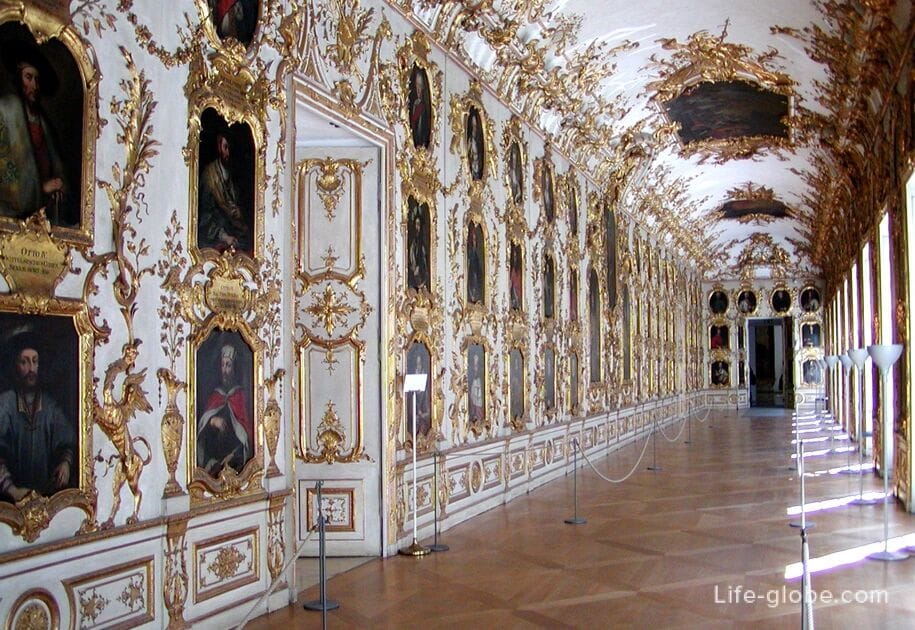
- Hofgarten Park, adjacent to the north wing of the Munich Residence and which was originally erected as a court garden
The park is bordered on both sides by arcades. On the eastern side of the park is the Bavarian State Chancellery. The center of the park is decorated with a pavilion (the temple of Diana), created by Heinrich Schon the Elder in 1615.
The main entrance to the park is from Odeonsplatz;
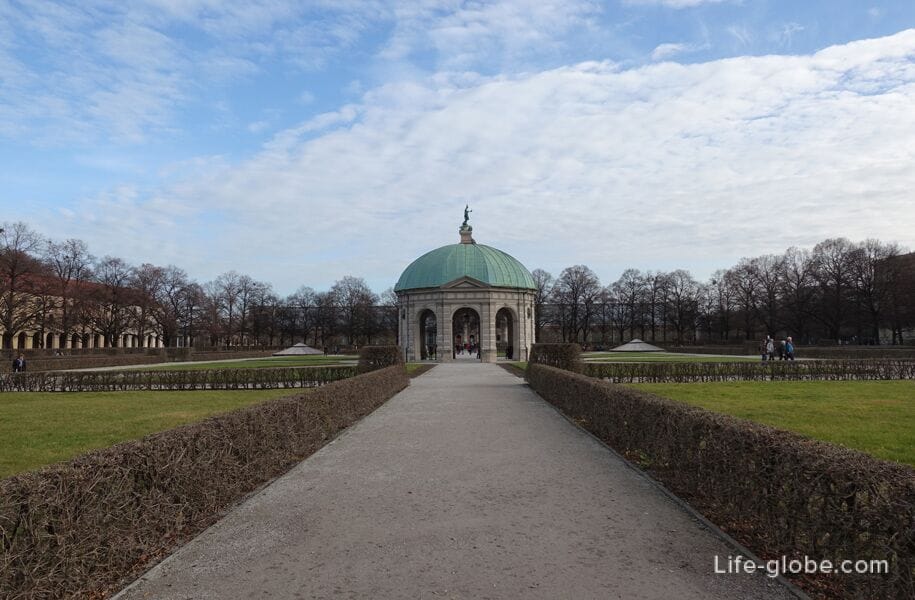
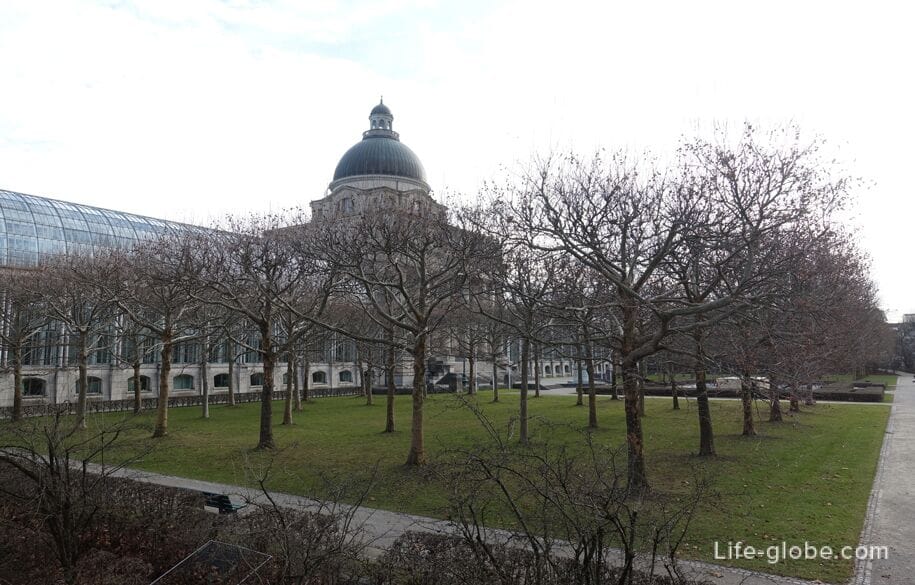
- the city gates and the remains of the fortifications that once surrounded Munich, the most interesting of which are:
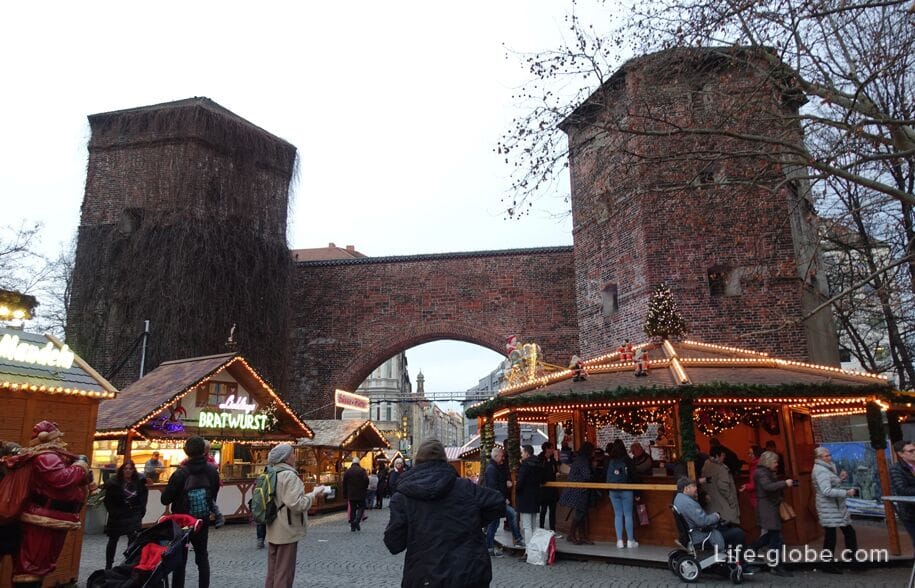
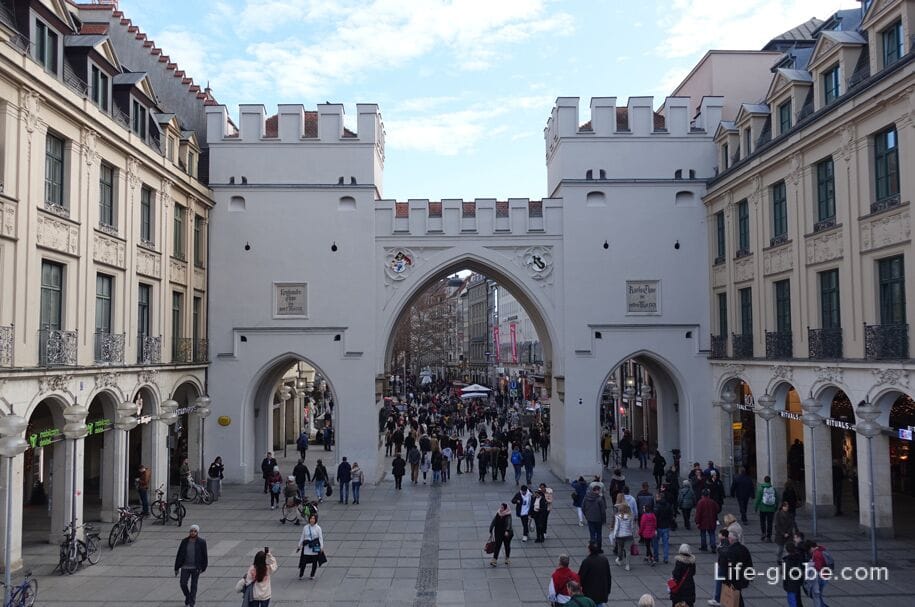

- Frauenkirche - the current cathedral of the Catholic Archdiocese of Munich and Freising, whose history dates back to 1468.
The church building is distinguished by two high towers-bell towers. At the top of the south tower is an observation deck, giving panoramic views of the city and the surrounding area.
Address: Frauenplatz, 12;
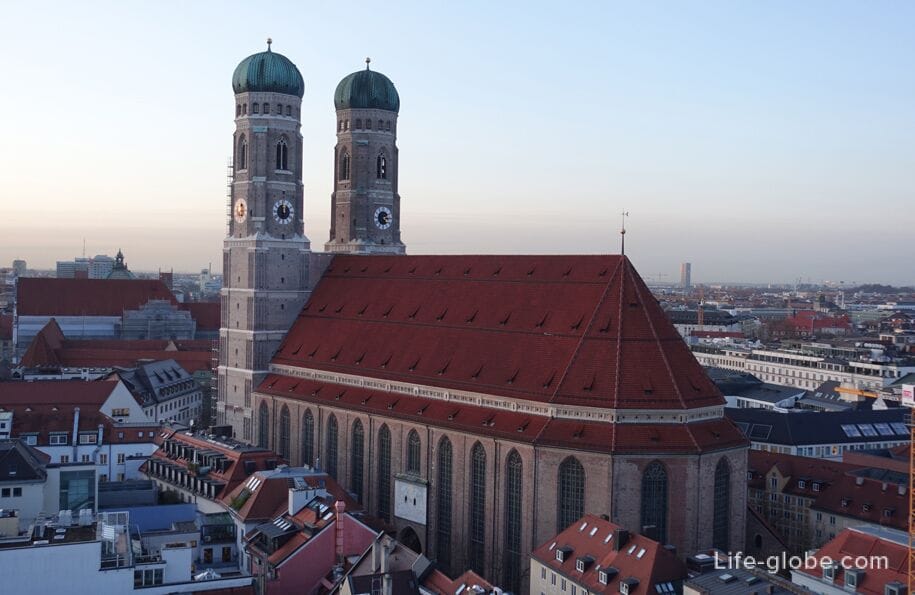
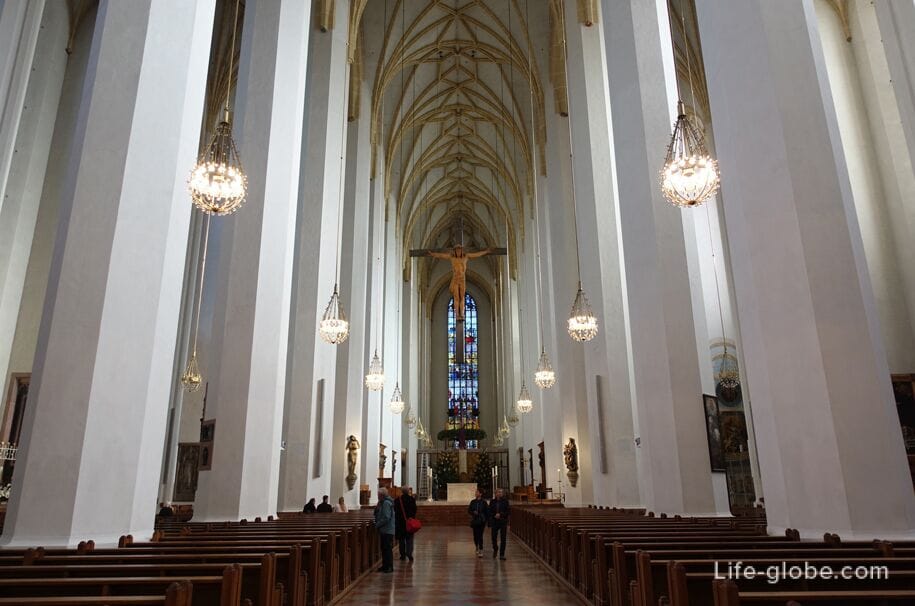
- St. Peter's Church (Peterskirche), also known as "Old Peter" (Peterskirche, Alter Peter) and dating back to the 11th century.
In the walls of the church in a glass sarcophagus are the relics of one of the first Christian martyrs - Saint Munditia of Rome (Saint Munditia), decorated with jewels.
The bell tower of the church has a circular viewing platform that offers panoramic views, including the Marienplatz square, the old town and the surrounding area.
Address: Rindermarkt, 1;
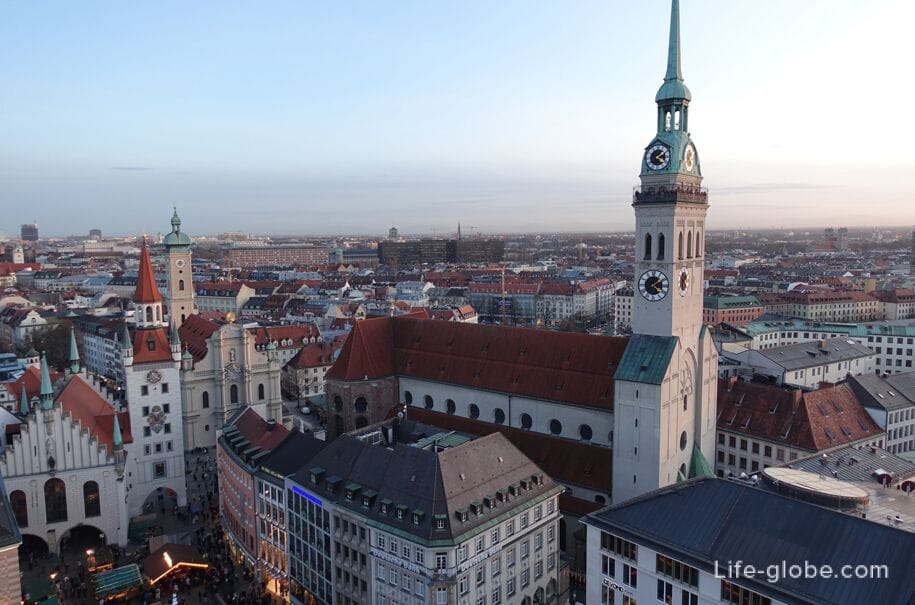
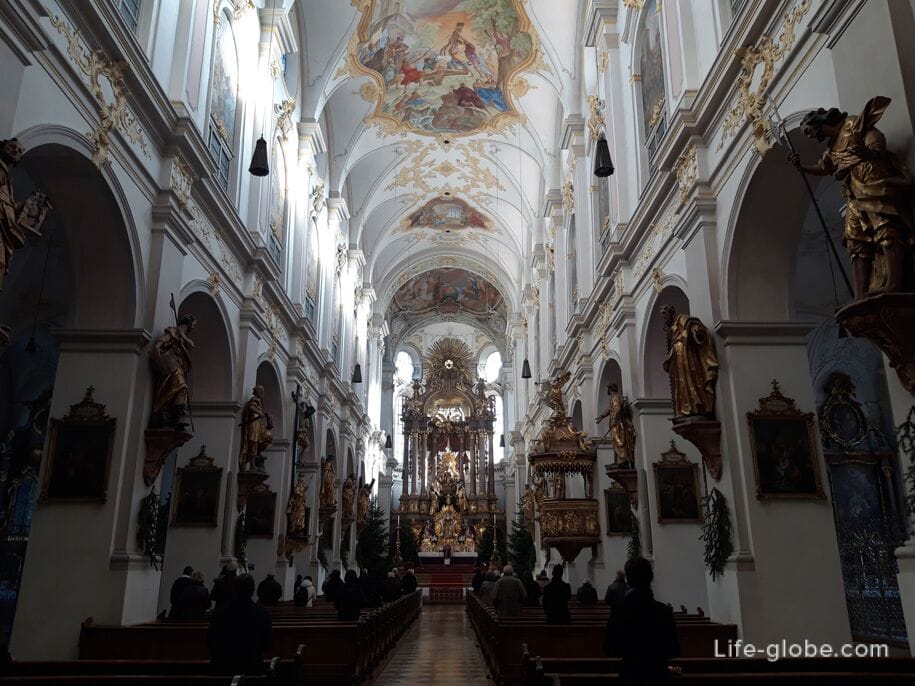
- The Hofbroyhaus (Hofbräuhaus) is one of the oldest beer restaurants in Munich, which was founded as a court brewery in 1589.
At the beginning of the 20th century, the Hofbroyhaus became one of the most popular places for recreation and meetings of citizens.
Currently, the Hofbroyhaus functions as a beer restaurant with a beer garden and is known not only in Munich, but also outside the city.
Address: Platzl square, 9 (Platzl). Website: hofbraeuhaus;
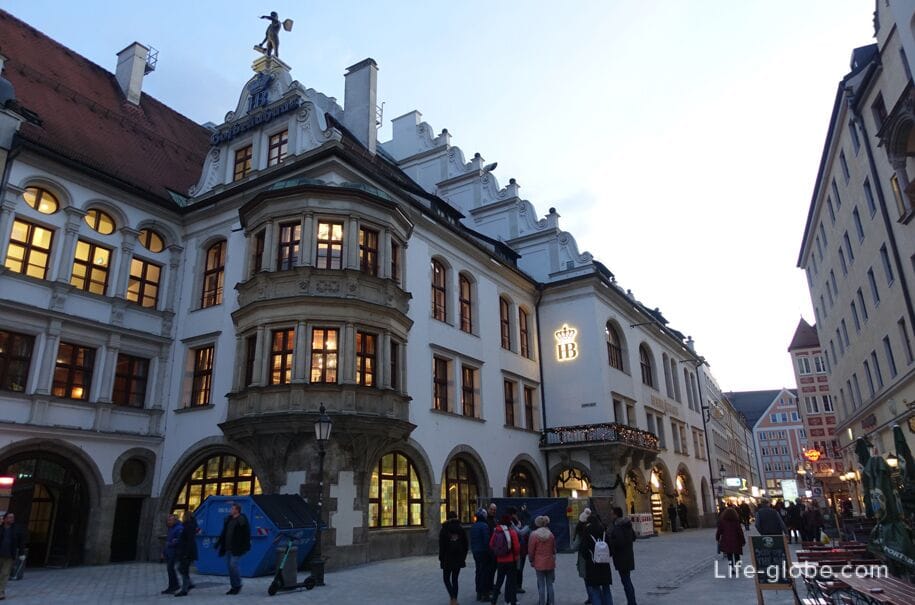
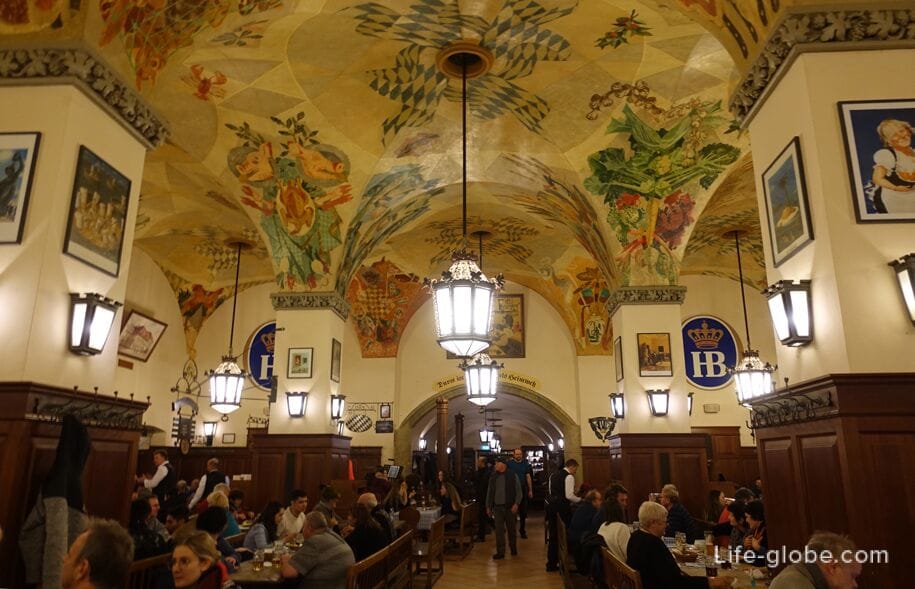
- Azamkirche and the house of the Azam brothers (Asamhaus), together representing an architectural ensemble and a masterpiece of the late Baroque, built by the Azam brothers since 1733.
Address: Sendlinger starsse street, 32 and 34 (Sendlinger Str.);
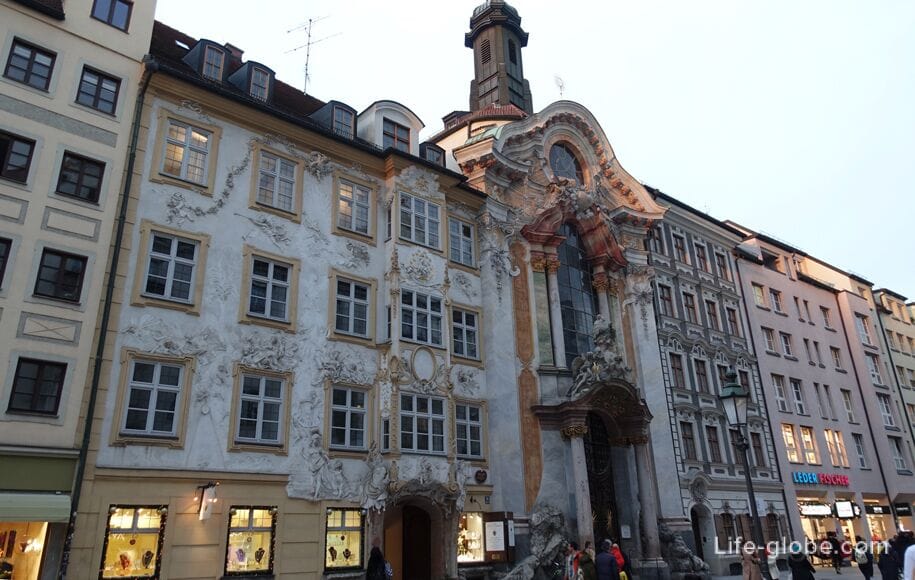

- Odeonsplatz, built under King Maximilian I of Bavaria on the site of the city wall destroyed in 1791.
The Odeonsplatz is notable for:
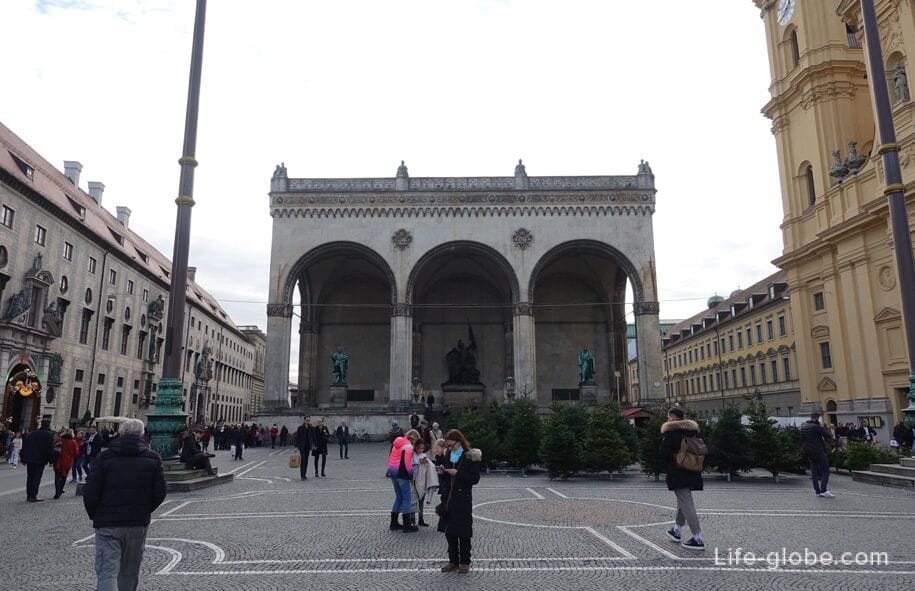
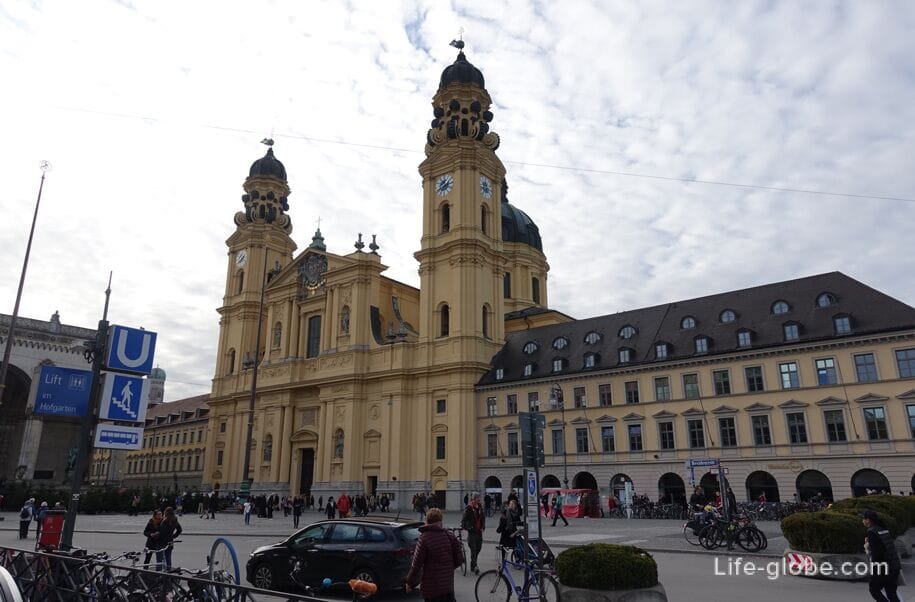

- Max Joseph Square (Max-Joseph-Platz), created in the early 19th century and named after King Maximilian I Joseph of Bavaria.
The center of the square is decorated with a monument to King Maximilian I, and around the square are concentrated such important objects of Munich as:

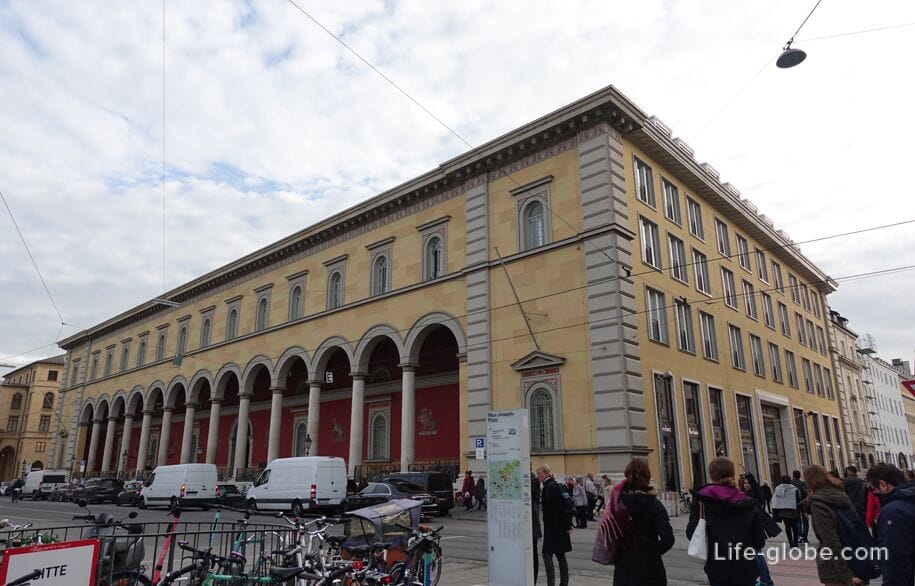
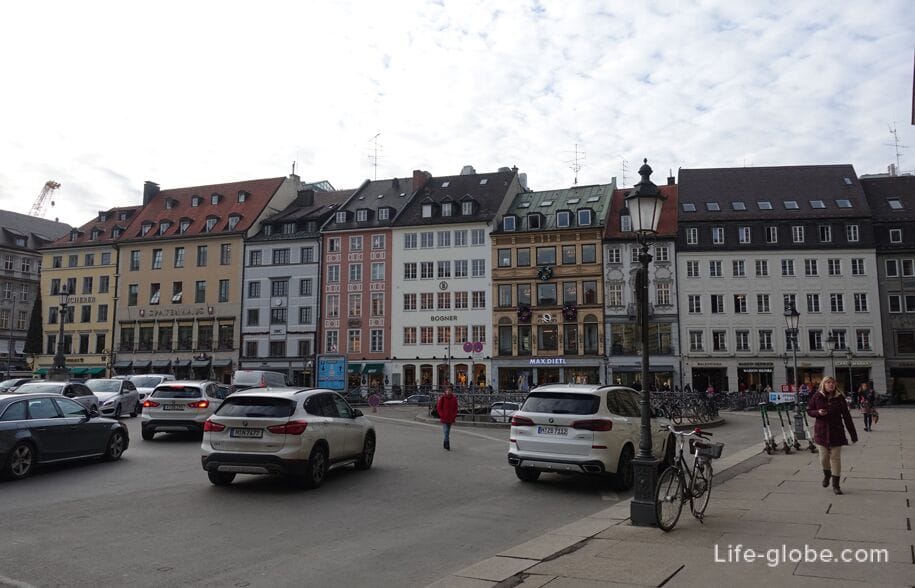
- St. Jakobs Square (Sankt-Jakobs-Platz), which is restricted from vehicle traffic. On the square are:

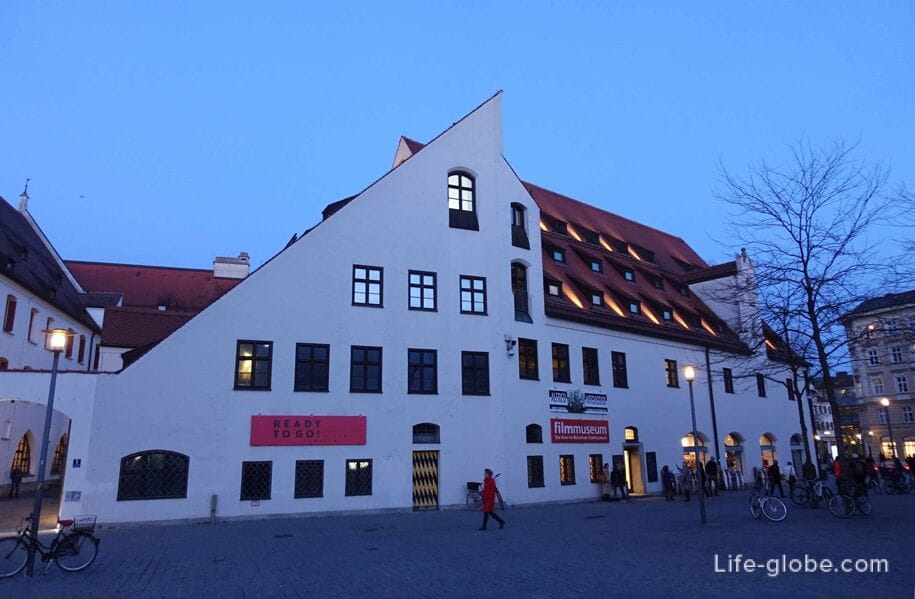
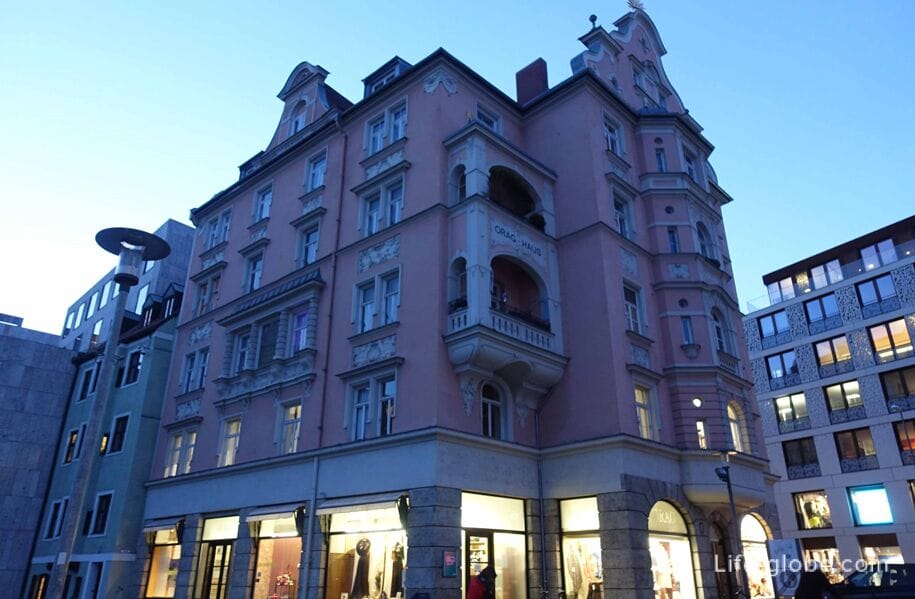
- Karlsplatz, which marks the western border of Munich's historic old town.
The dominant feature of the square is the Charles Gate. Also on the square is: a fountain, a department store and a shopping center. In the winter season, from about mid-November to mid-January, the square has an open-air ice rink;
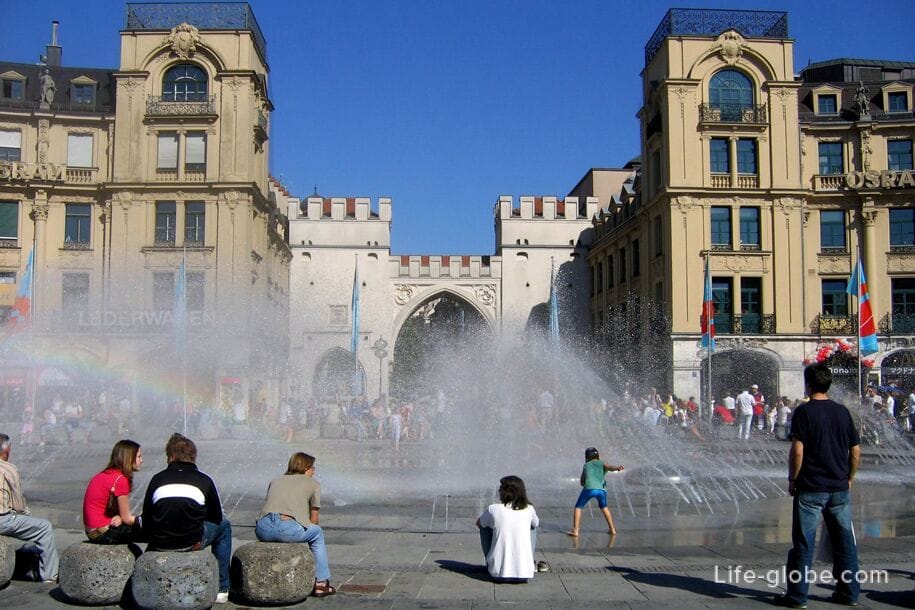

- Viktualienmarkt is an open-air market that operates all year round (from Monday to Saturday, except public holidays, from 8: 00 to 20: 00).
On the market is beer garden "Biergarten Am Viktualienmarkt", which, although not the largest in Munich, is certainly the most central;
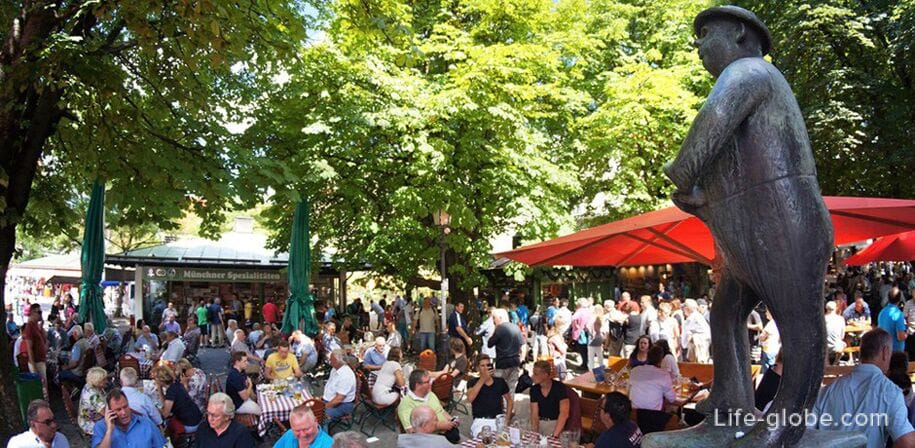
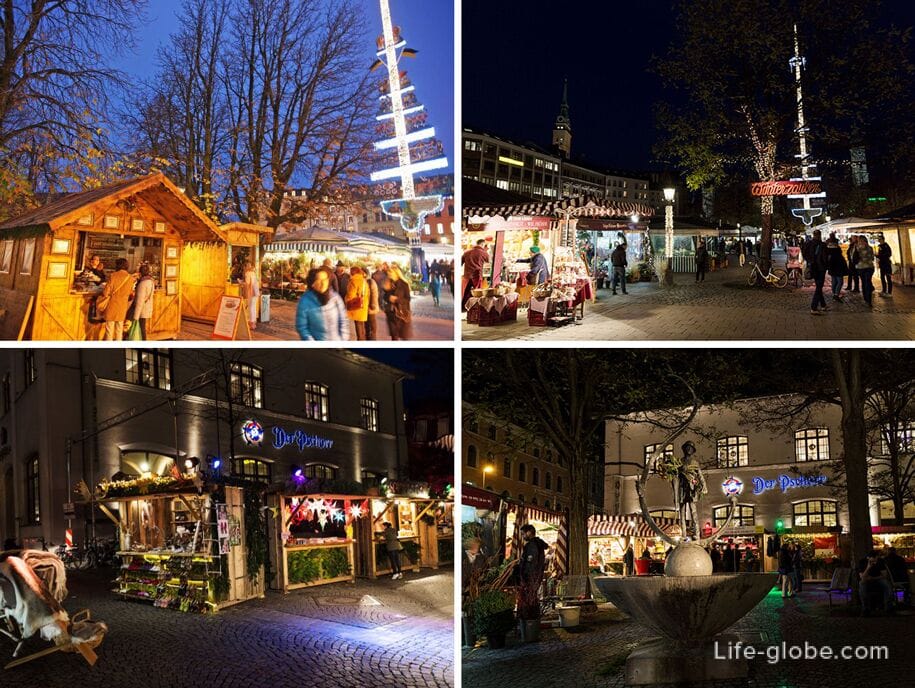
- St. Michael's Church (Jesuitenkirche St. Michael), considered the largest and first Renaissance church north of the Alps.
The church was built by Duke William V of Bavaria between 1583-1597.
The exterior of the church, due to the gable main facade and triangular front, looks more like an old medieval town hall than a shrine.
The interior of the church is decorated in light colors and impresses with golden altars and a pulpit. The main high altar is located in the apse and with the figure of the Savior. Very deep choirs adjoin the mighty nave.
In the church crypt is the tomb of a relative of Napoleon I-Eugene de Beauharnais, and the tombs of members of the Wittelsbach dynasty, including Maximilian I, William V, King Ludwig II of Bavaria, etc.
Address: Neuhauser strasse, 6 (Neuhauser Straße);

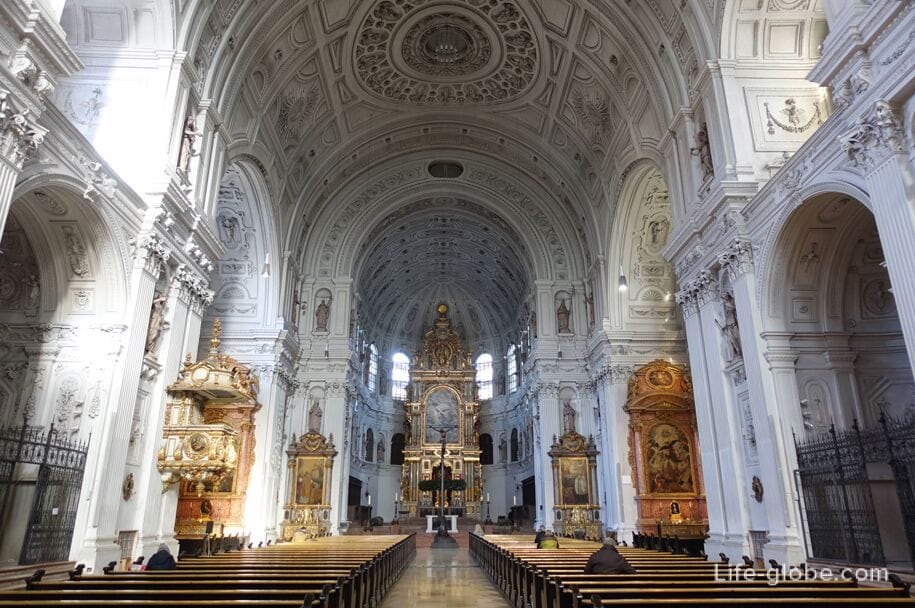
- Wittelsbach fountain (Wittelsbacher Brunnen), built in 1893-1895 in the classical style and is considered the most beautiful fountain in Munich.
The motif of the fountain is an allegory of the natural forces of water. Thanks to its restrained, clear and at the same time refined design, as well as from the point of view of urban planning, the fountain is one of the most artistically perfect structures in Munich.
The fountain is located on the border of the squares Lenbach (Lenbachplatz) and Maximiliansplatz (Maximiliansplatz).
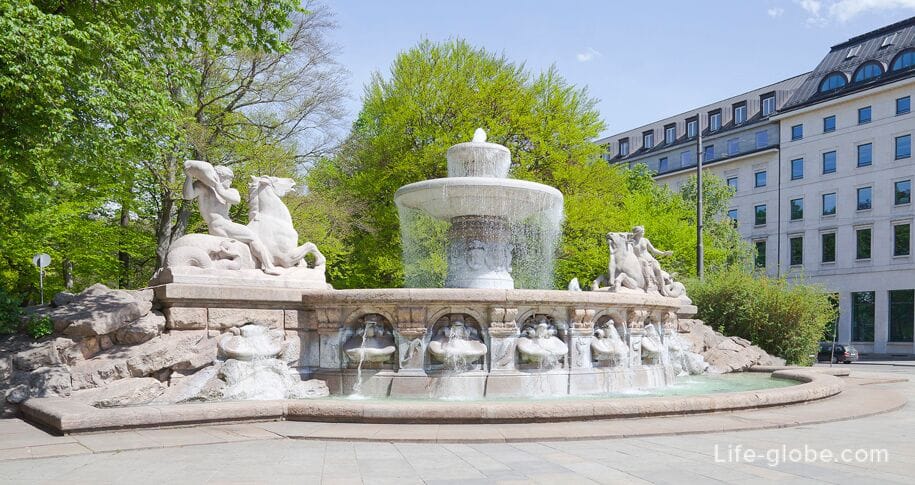
Within the old town there are also streets, the most interesting visited of which are: Rindermarkt; Sendlinger strasse (Sendlinger Straße); Residence street (Residenzstraße), Burgstrasse (Burgstraße), Cardinal Faulhaber Street (Kardinal-Faulhaber-Straße); Kaufingerstrasse and Neuhauser Strasse (Kaufingerstraße, Neuhauser Straße), etc. Learn more about Munich's old town...
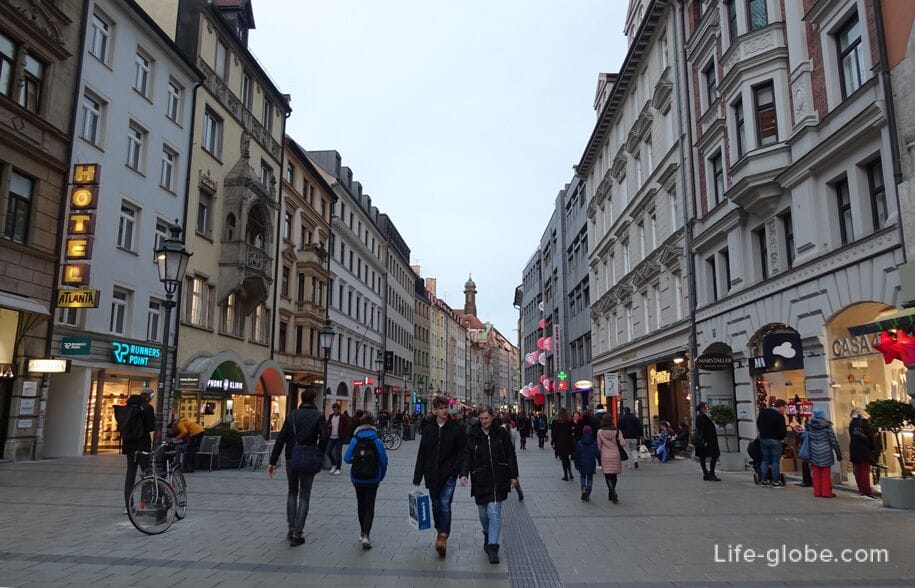
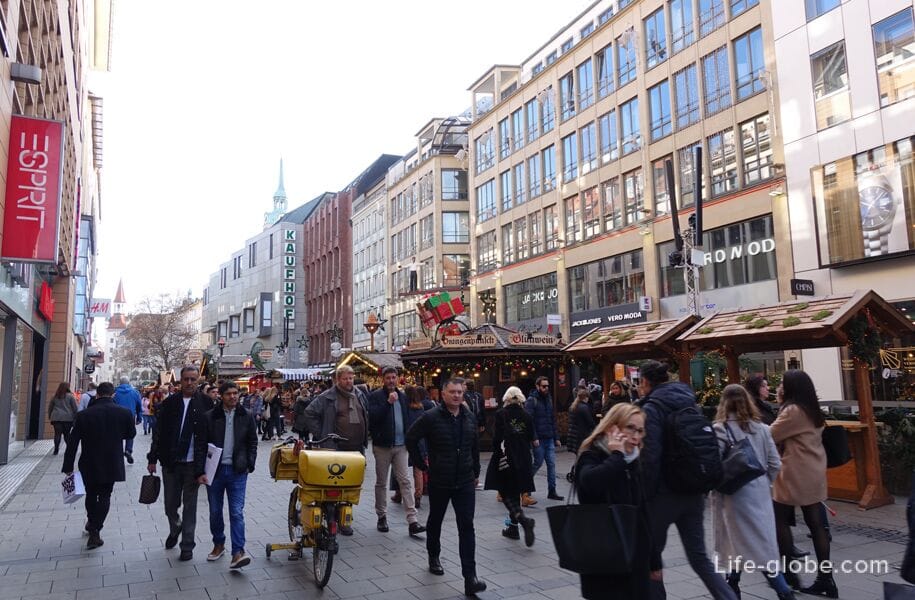
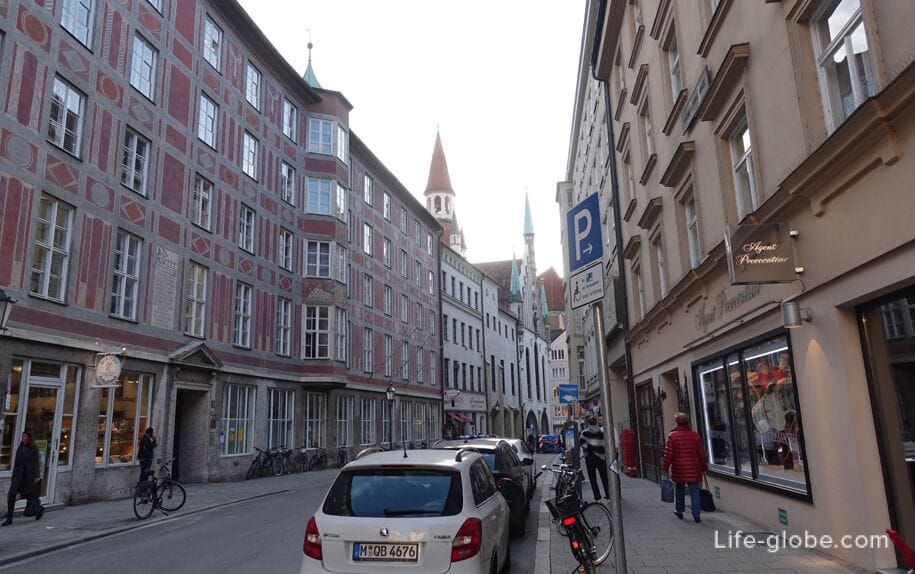
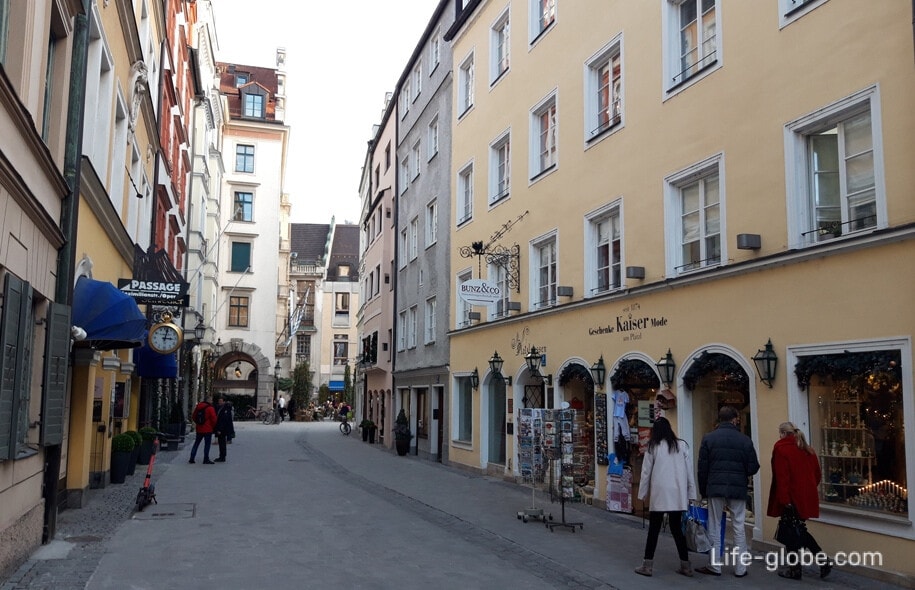
The Old Botanical Garden (Alter Botanischer Garten) was established between 1804 and 1812.
In 1914, a new botanical garden was created near the Nymphenburg Palace, on the former outskirts of Munich. In 1937, the old botanical garden was turned into a public park.
In the park: Neptunbrunnen Fountain, created in 1937; Kunstpavillon, created as an exhibition space in 1936; memorial to the world's first long-distance power transmission line Miesbach-Munich in 1882; cafes; places to relax and walk.
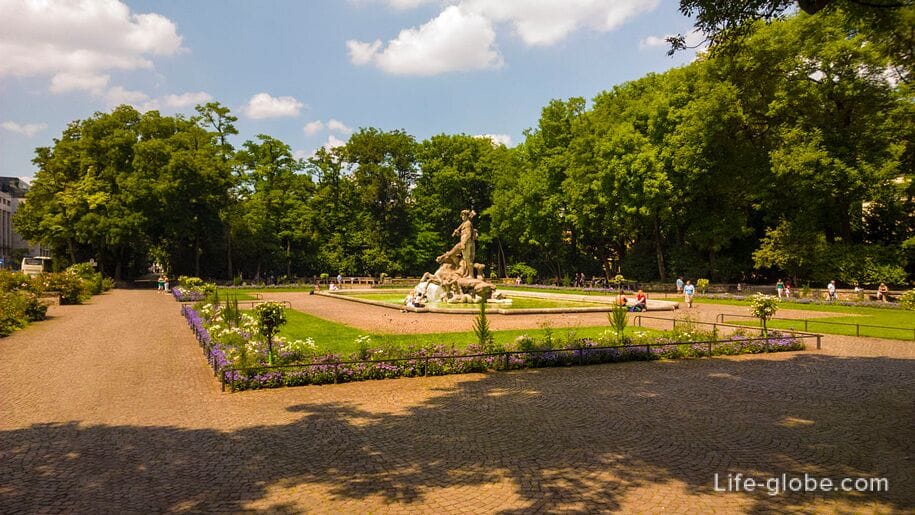
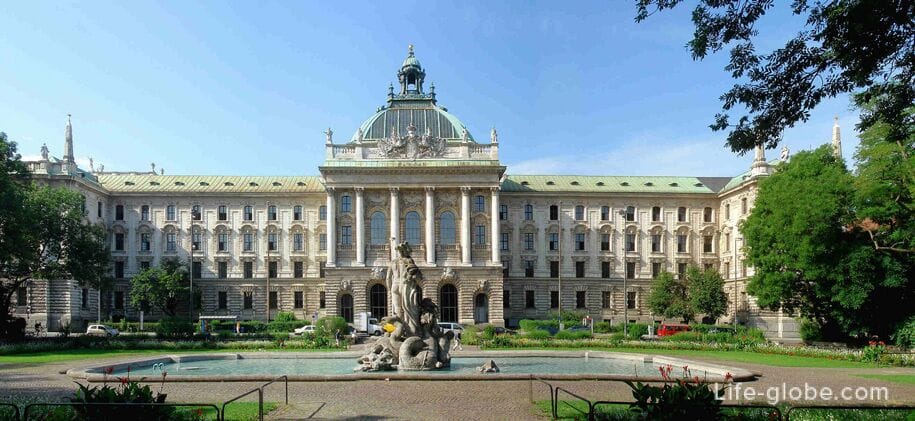
The Nymphenburg Palace (Schloss Nymphenburg) is a palace complex that is one of the most majestic royal palaces in Europe.
The palace was built starting in 1664, and for many years served as the main summer residence of the rulers of Bavaria from the Wittelsbach dynasty.
Some of the halls and rooms of the palace still display their original Baroque decorations.
The palace complex also includes two museums: Carriage Museum (Marstallmuseum) and Porcelain Museum (Porzellanmuseum).

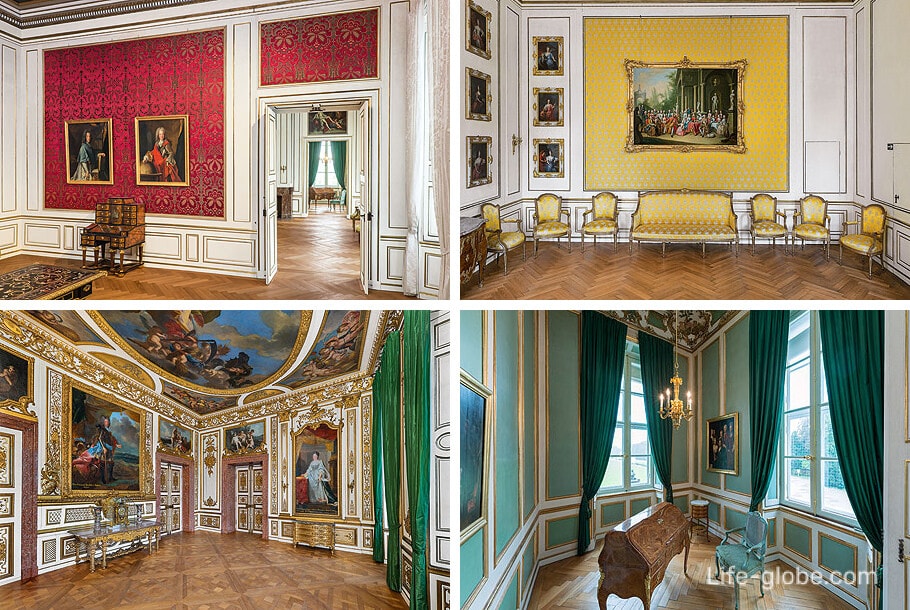
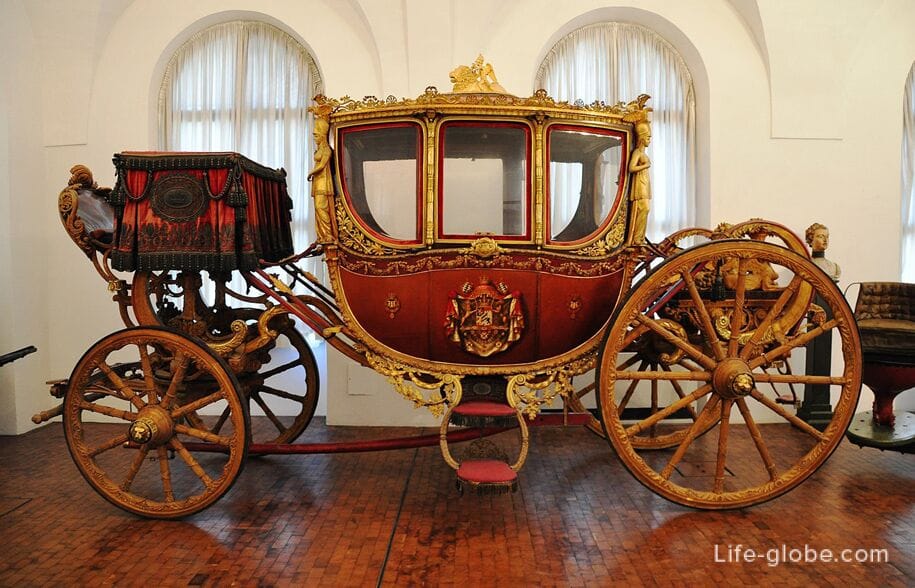
The palace is adjacent to the park of the Nymphenburg Palace (Schlosspark Nymphenburg) in which are: the central canal with the "Grand Cascade" - a Baroque waterfall; fountains; alleys and paths for walking; statues and sculptures; two lakes and the monopter Apollo-Tempel (Apollo-Tempel) - a rotunda temple, built in 1862-1865.
For a fee, you can visit several pavilions - palaces in miniature in the park.
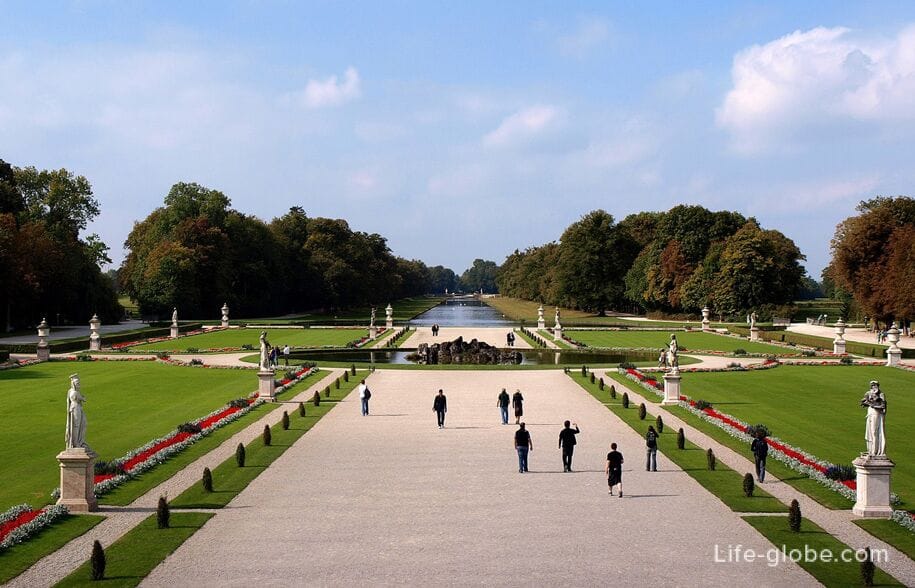
Address of the palace and park: Schloß Nymphenburg, 1. Nymphenburg Palace website: schloss-nymphenburg. More about the Nymphenburg Palace and the park…
The English Garden (Englischer Garten) is a large public park in the center of Munich, which is one of the largest urban parks in the world.
The park has existed for more than 230 years.
Currently, the English Garden is a popular place for walking, recreation and sports, both among local residents and visitors to the city.
On the territory of the park there are several significant attractions, including: an observation deck with a rotunda, a Japanese tea house, part of the Berlin Wall, a Chinese tower, a "standing" wave on the Eisbach, restaurants with beer gardens, etc. Learn more about the English Garden…

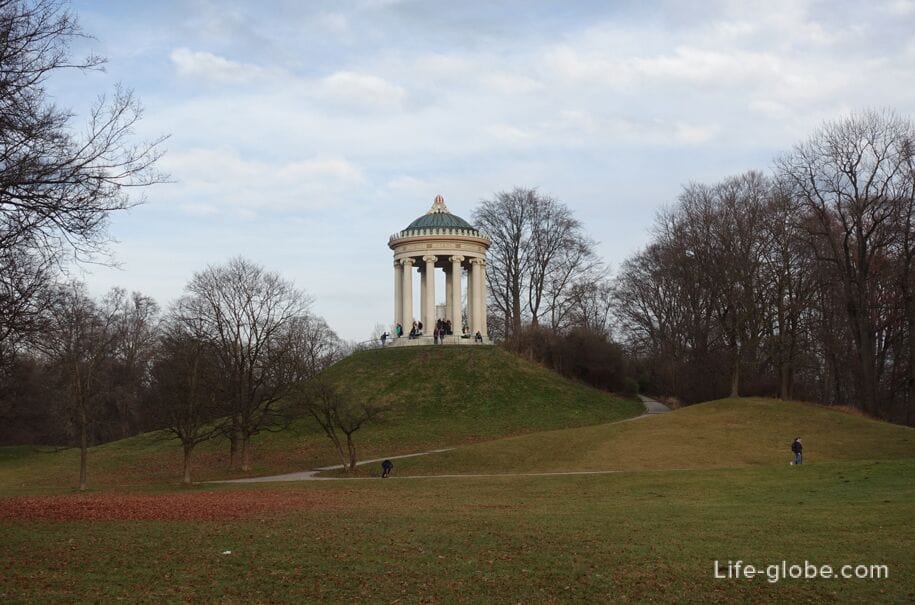
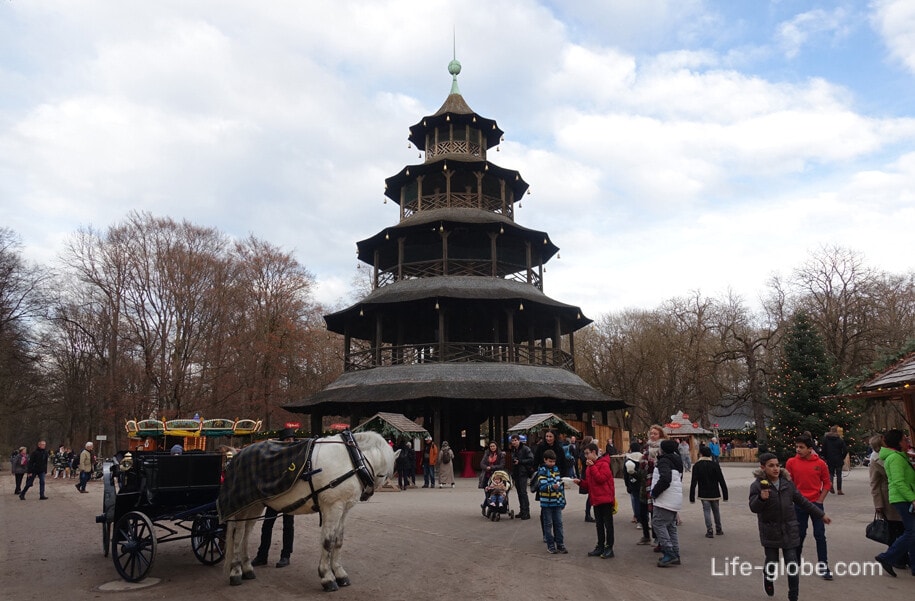

The Olympic Park (Olympiapark) is a park complex that was built for the 1972 Summer Olympics in Munich.
Today, the Olympic Park serves as a venue for sports, cultural, social and religious events and festivals, as well as a place for sports, walking and recreation.
In addition to the sports facilities themselves, the Olympic Park complex includes: a landscape park with Olympic Observation Mountain, Lake Olympia, Munich Olympic Avenue of Stars, beer garden, restaurants, Olympic Observation Tower (the highest observation deck in Munich), aquarium, residential area and shopping center. Learn more about the Olympic Park...
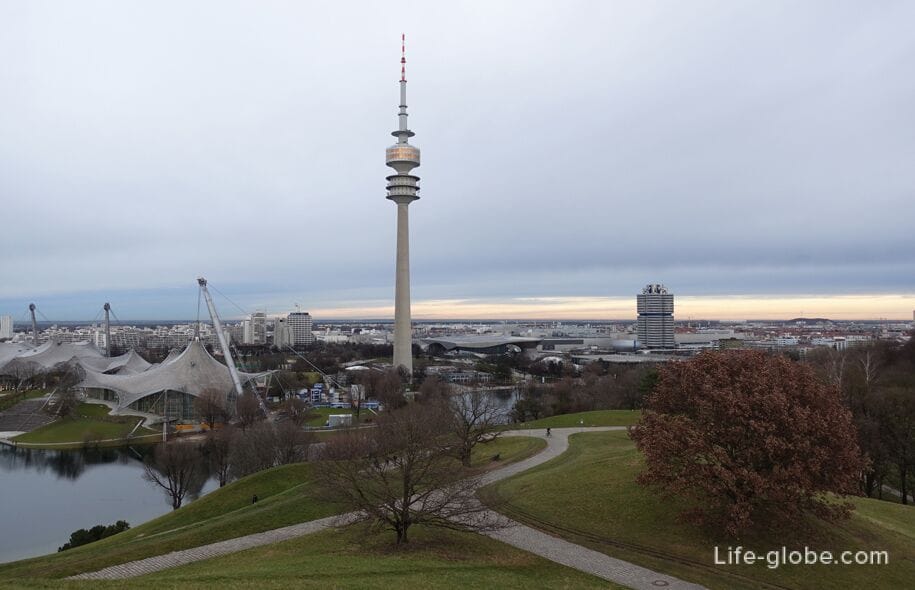

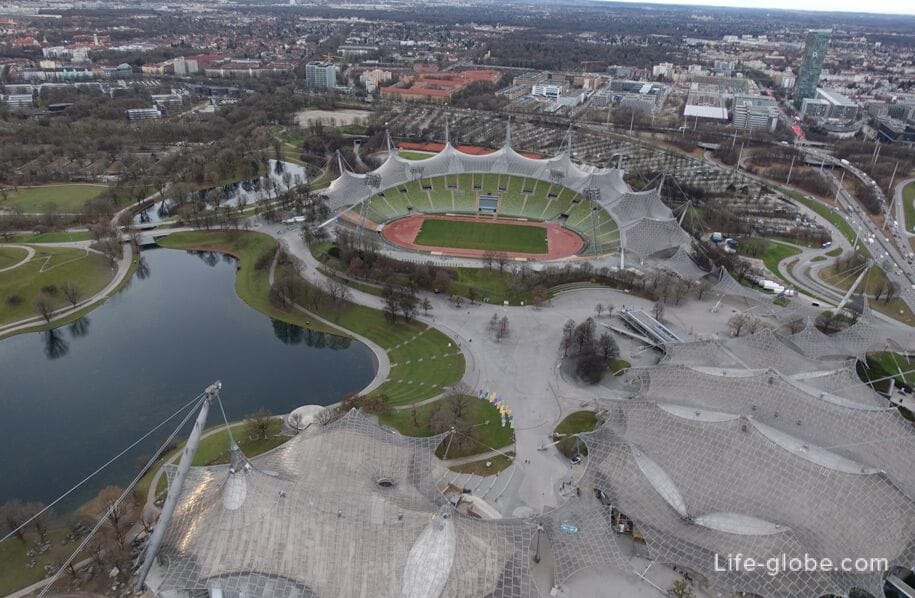
The BMW Museum is an automobile museum dedicated to the history of the BMW brand and products.
On the exhibition areas of the museum are the original and most interesting exhibits of cars and motorcycles of different years, engines and turbines of aircraft. Some of the museum's spaces are dedicated to advertising, design, and the development of the BMW brand.



Next to the museum is the BMW Welt - a multifunctional exhibition center designed for the presentation of BMW products, distribution of BMW cars, conferences and forums.


Address of the BMW Museum: Am Olympiapark, 2.
Address of the center BMW Welt: Am Olympiapark, 1.
Website: bmw-welt. Learn more about the BMW Museum and exhibition center…
The area of Art (Kunstareal München) - the art zone - is the museum quarter and cultural center of Munich, which is an area where the city's important museums and galleries are concentrated:
- Old Pinakothek (Alte Pinakothek) - a museum with a collection of paintings by masters from the Middle Ages to the middle of the 18th century;
- New Pinakothek (Neue Pinakothek) - a museum that presents paintings and sculptures by masters of the second half of the 18th and early 20th centuries;
- Pinakoteka of modernity (Pinakothek der Moderne) - one of the world's largest art museums of modern art, mainly 20-21 centuries;
- Brandhorst Museum (Museum Brandhorst) - an art museum dedicated to contemporary art from the late 1950s to the present day;
- Museum of Egyptian Art (Staatliches Museum Ägyptischer Kunst) - an archaeological museum containing the Bavarian state collection, which focuses on the art of ancient Egypt;
- Glyptothek - a museum with a collection of ancient sculpture and glyptics;
- State Antique Collection (Staatliche Antikensammlung) - a museum that houses one of the most extensive collections of Greek, Etruscan and Roman art in Germany;
- city gallery in the house of Lenbach (Städtische Galerie im Lenbachhaus) - an art museum with a collection of works by Munich artists, especially from the 18th-19th centuries;
- geological museum dedicated to the rock history of Bavaria, geological processes and cycles, changes in the earth's crust and raw materials of our planet;
- paleontological museum dedicated to the history of the Earth and life, showing fossils of animals and plants from the epochs of earth's history;
- the Nazi Party Documentation Center (NS-Dokumentationszentrum), focusing on the history and consequences of the Nazi regime and the role of Munich as the "movement capital" of National Socialism;
- the Museum of casts of classical images (Museum für Abgüsse Klassischer Bildwerke) is a gallery with a collection of plaster copies of famous ancient Greek and Roman sculptures (statues and busts from 700 BC to 500 AD), which were reproduced in accordance with the originals;
- the museum "Kingdom of Crystals" (Museum Reich der Kristalle), which presents collections of minerals and fossils, including diamonds, emeralds and other precious stones and minerals. There are also collections of meteorites, quartz from the Alpine region, and minerals from the Bavarian ore deposits. Learn more about the Area of art and museums…

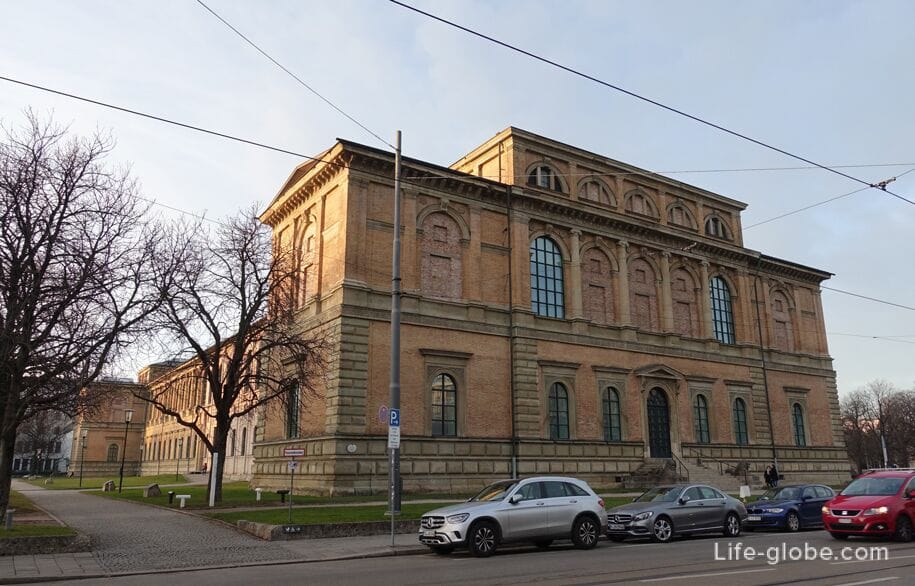
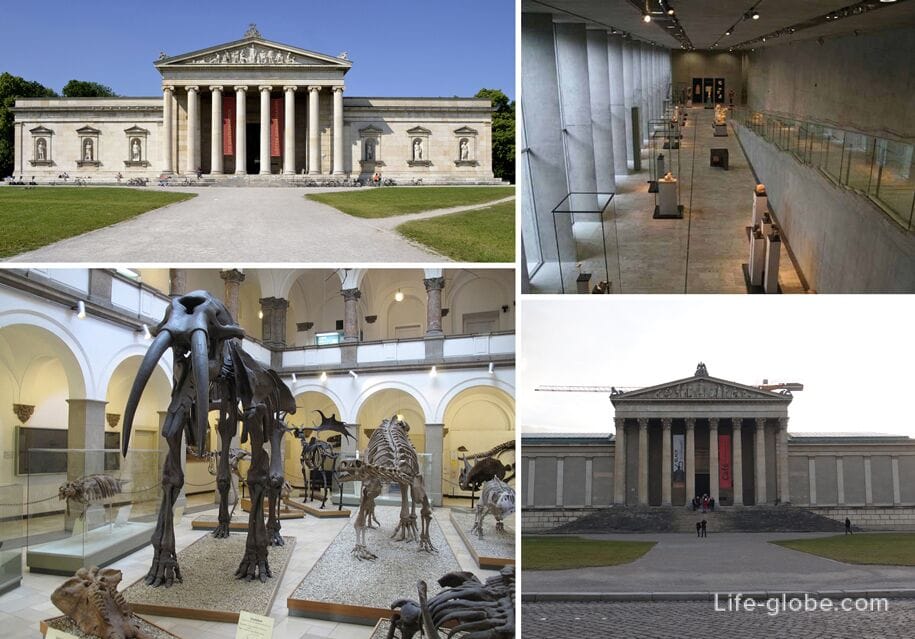
In the 19th century, four royal avenues were built in Munich, which led from the city center.
The Royal Avenues are now important city boulevards located in the center of Munich and along which there are, among other things, museums, former palaces, magnificent buildings and squares.
Brienner Strasse
Briennerstrasse (Brienner Straße) has been built in the neoclassical style since 1812.
Brienner Street runs from the northern edge of Munich's old town (Odeonsplatz) in a northwesterly direction to Nymphenburger Strasse (Nymphenburger Straße).
The street intersects three significant squares of the city: Wittelsbach Square (Wittelsbacherplatz), considered the most beautiful classicist square in Munich, square Karolinenplatz, the center of which is decorated with a high obelisk and The Royal Square (Königsplatz), which houses two museums (Glyptothek and the State Antique Collection) and the main gate - Propylaea(Propyläen). Learn more about Briennerstrasse...


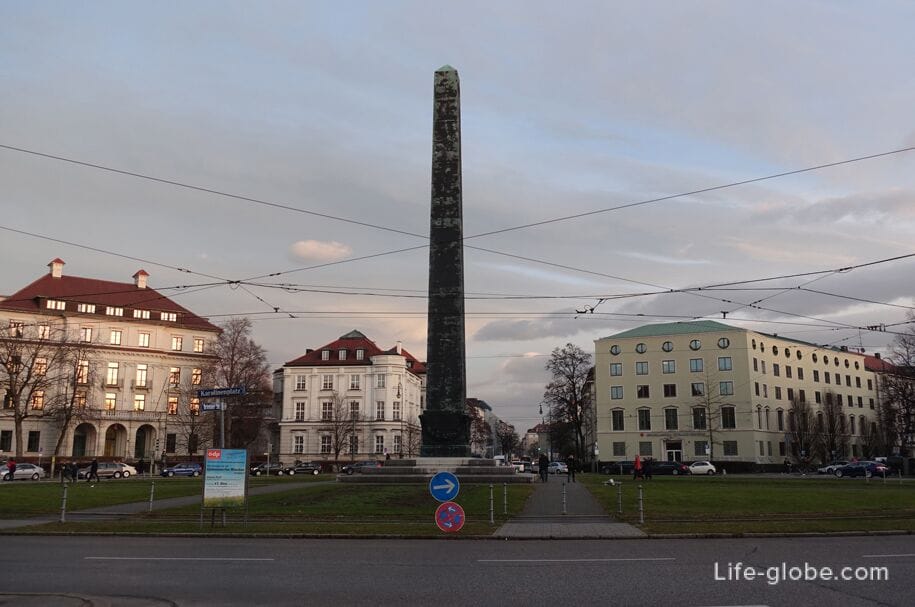
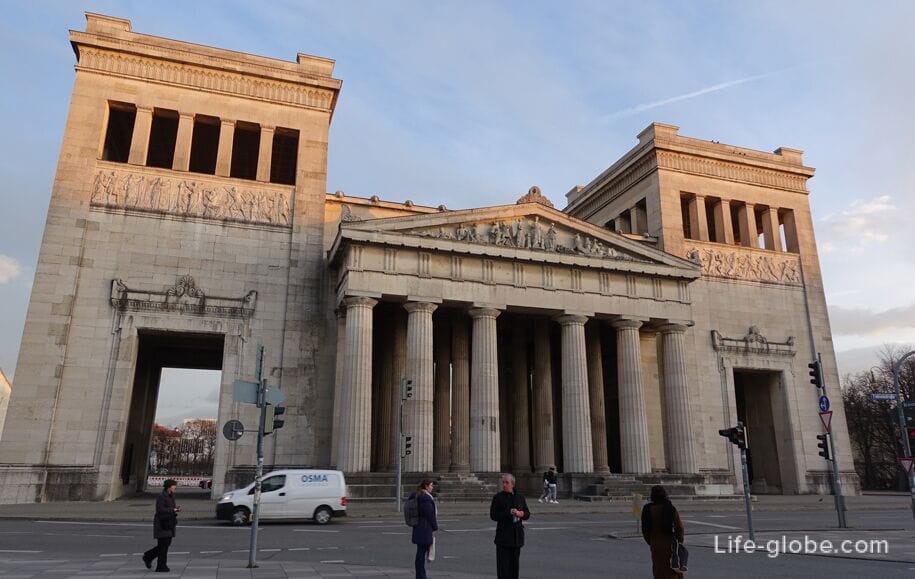
Ludwigstrasse
Ludwigstrasse (Ludwigstraße) was built on the initiative of King Ludwig I of Bavaria (and named after him), starting in 1816 as the "great" street representing the Kingdom of Bavaria.
The street stretches from the Odeonsplatz square absolutely straight in a north-easterly direction and ends at the Victory Gate.
Main objects on Ludwigstrasse: the building of the Bavarian Archive Office, the building of the Bavarian State Social Court, the Bavarian State Library, the Church of St. Ludwig, the Roman Catholic Seminary, the Ludwig-Maximilian University, fountains, the White Rose Memorial and Victory Gate (Siegestor) - a majestic Triumphal Arch dedicated to the glory of the Bavarian Army. Learn more about Ludwigstrasse…


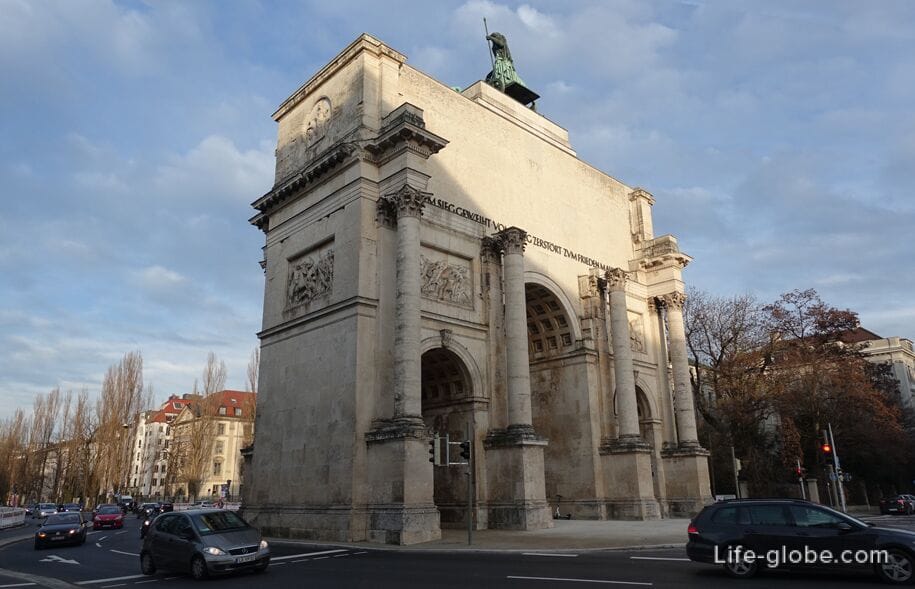
Maximilianstrasse
Maximilianstrasse (Maximilianstraße) is one of the most expensive streets in Germany with high retail rents.
The construction of the avenue began in the 1850s by decree of King Maximilian II of Bavaria, after whom the street was named.
The street connects the Max Josef Square in Munich's old town with the historic the Maximilianeum building (Maximilianeum).
Along the street are located: Vier Jahreszeiten Kempinski München 5-star Hotel, munich Chamber Theater "Kammerspiele" (Kammerspiele), Upper Bavaria Government building, five Continents Museum (museum Fünf Kontinente), the monument to Maximilian II and the buildings known for their galleries, which house retail outlets of world brands, designer and jewelry stores, boutiques and salons. Learn more about Maximilianstrasse…
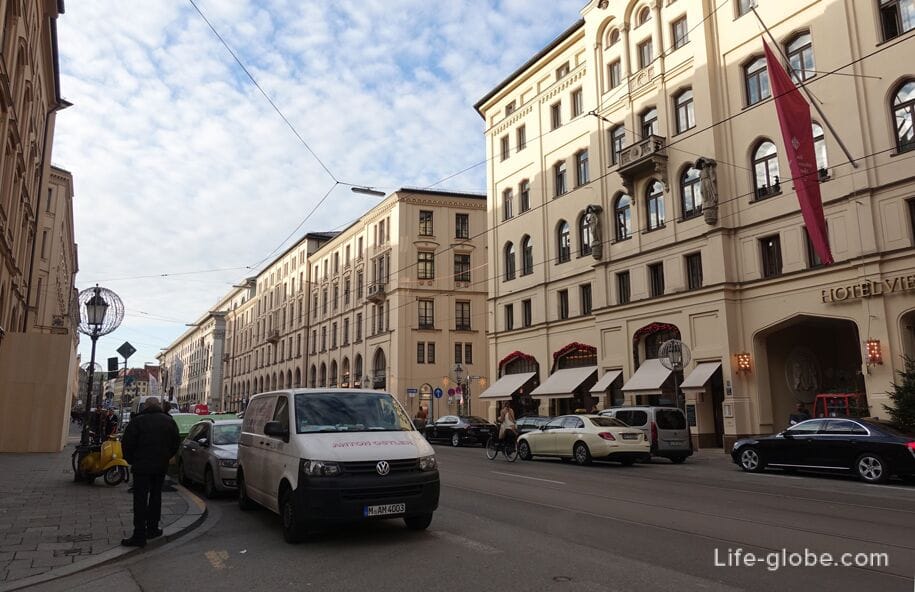
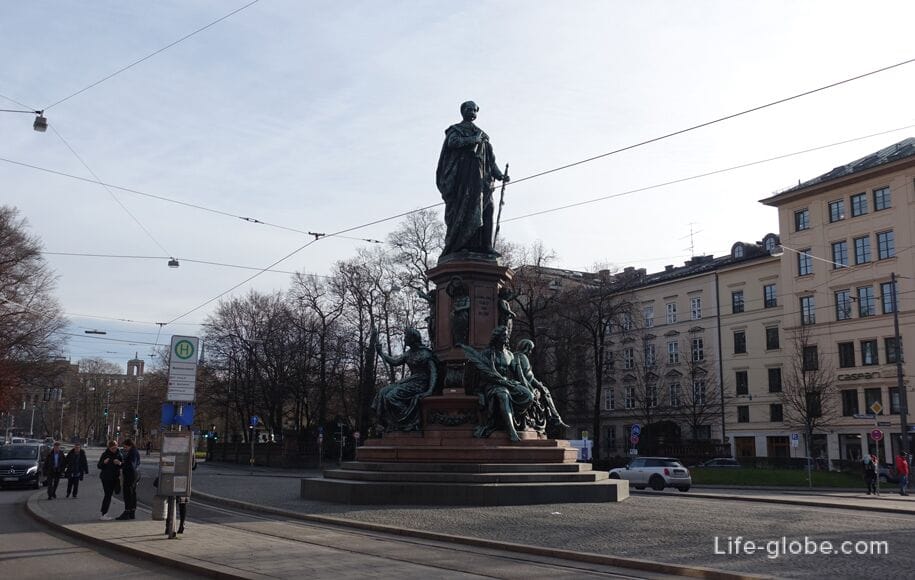
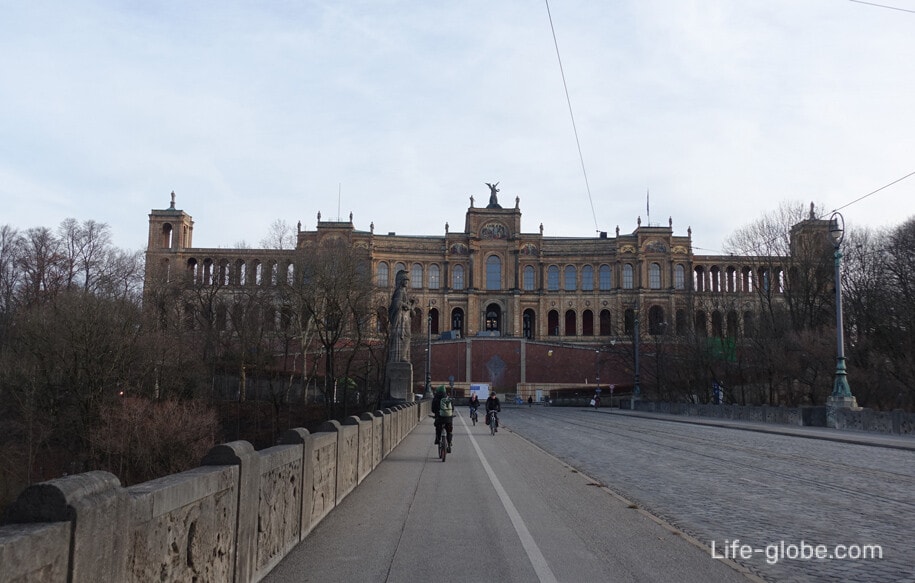
Prinzregentenstrasse
Prinzregentenstrasse (Prinzregentenstraße) was built, starting in 1891, as a main street for the middle class by order of the Prince Regent of Bavaria, Luitpold, and is named after him.
The Prinzregentenstrasse stretches from the north-eastern edge of Munich's old town in an easterly direction to its confluence with Einsteinstrasse (Einsteinstraße).
Along the street are located: prince Karl Palace, house of art, English Garden, Bavarian National Museum, Schack Collection, Angel of Peace memorial with viewing platform, villa Stuck, prince Regent's Theatre, prince Regent stadium and St. Gabriel's church. More about Prinzregentenstrasse…

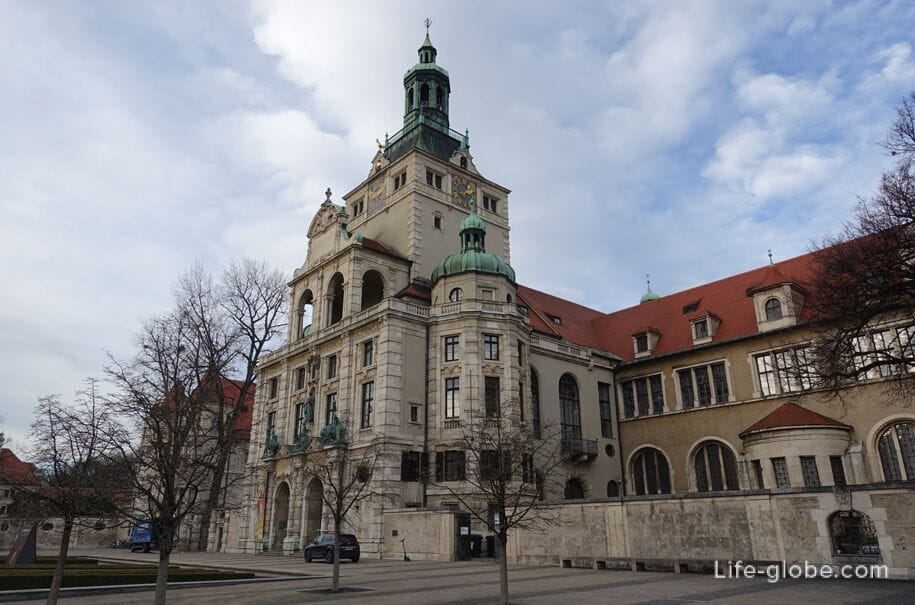
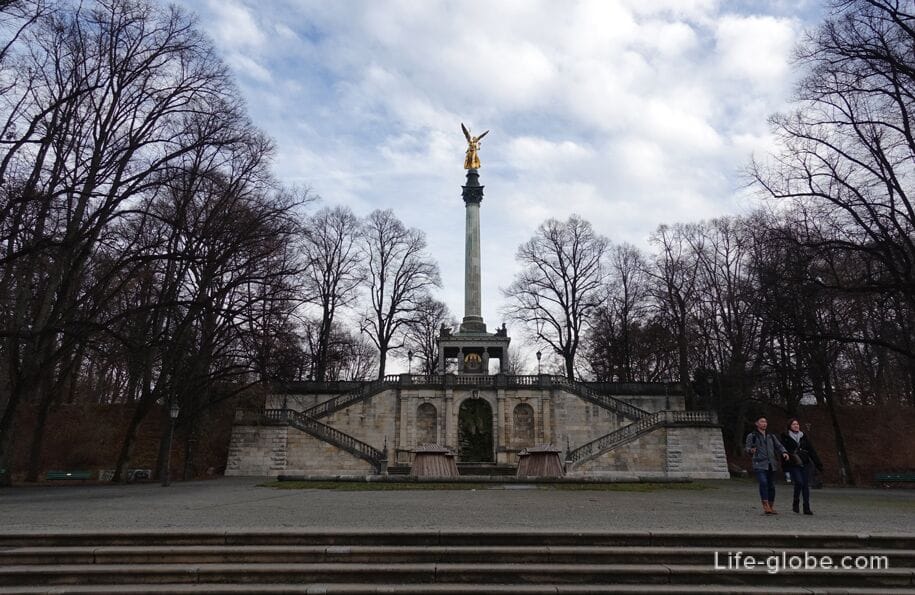
The sculpture "Walking Man" is a huge sculpture located in front of the building at the address: Leopoldsstrasse, 36 (Leopoldstraße).
The sculpture has a height of 17 meters and a weight of 16 tons. It is made of a steel structure covered with a fiberglass shell.
The sculpture was designed by American sculptor Jonathan Borofsky (Jonathan Borofsky )and made in Los Angeles (USA) in 1995.
For transportation, the sculpture was disassembled into nine parts and transported by plane to Munich,where it was reassembled.
This sculpture also has a name - "Man Walking to the Sky".
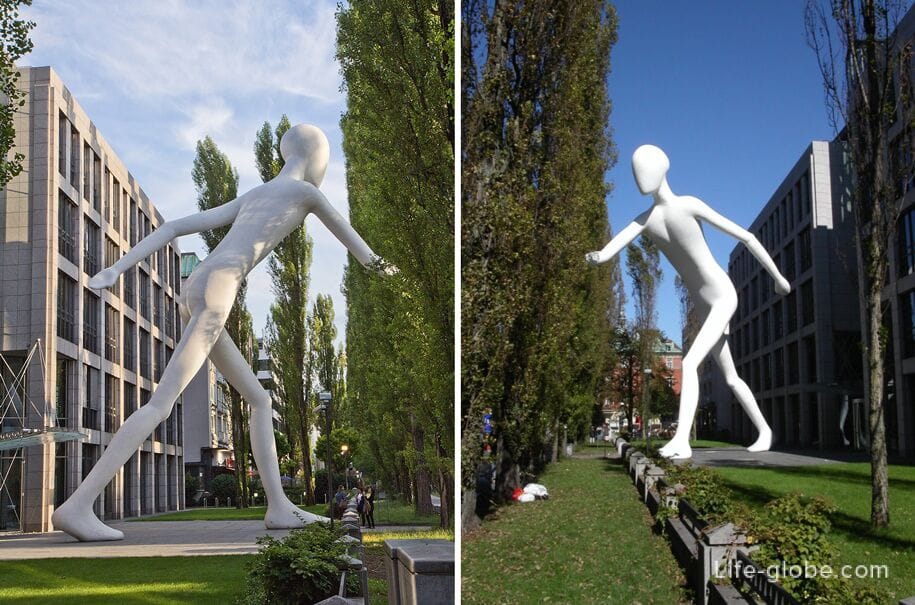
Richard-Wagner-Strasse (Richard-Wagner-Straße) is a street with a length of about 300 meters and was built in 1897.
The street is named after the composer Richard Wagner, who lived in the area in 1864-1865, < u>at the address: Brienner Strasse, 37.
The street houses were built between 1899 and 1906, mostly by architect Leochard Romeis. In the design of the street, the architect applied various architectural periods, taking into account the taste of late historicism, in order to create the impression of a "historical" street.

The memorial "November 8, 1939" (November 8, 1939) was erected in memory of the resistance fighters who fought against the Nazis.
Johann Georg Elser planned and executed an elaborate assassination attempt on Adolf Hitler and other high - ranking Nazi leaders-by bombing the Burgerbrückeller beer hall in Munich on November 8, 1939.
The attempt was a failure, and Elser was arrested and executed.
The memorial monument is installed on the facade of the building in a circle and in such a way that the elements of the inscription "November 8, 1939" visually form an explosion. Every evening at 21: 20 (the exact time of the bomb explosion), the numbers and letters of the memorial are highlighted one by one until the entire inscription is illuminated.
The memorial monument is located near the former place where Elser rented a room.
Address of the memorial: Turkenstrasse, 68 (Türkenstraße). Learn more about the memorial…
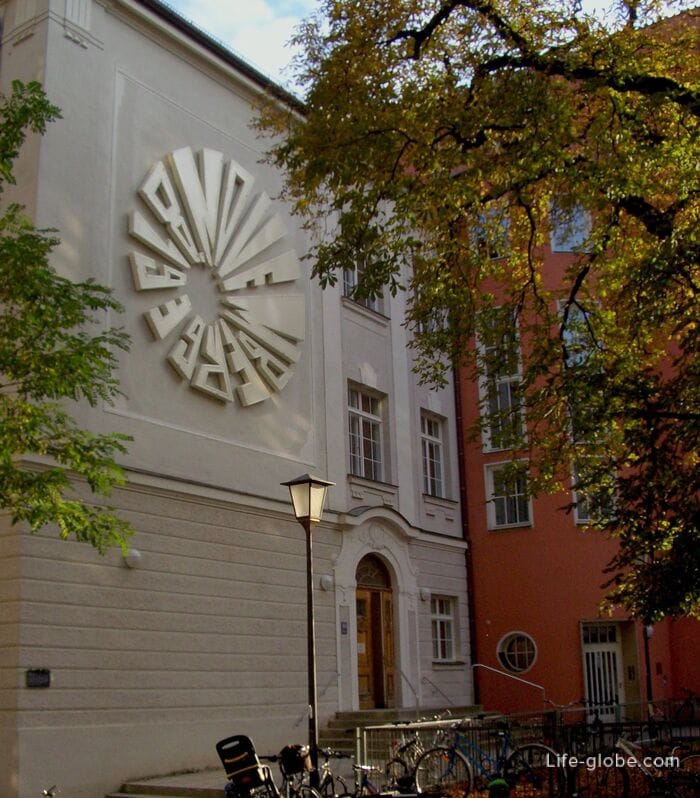
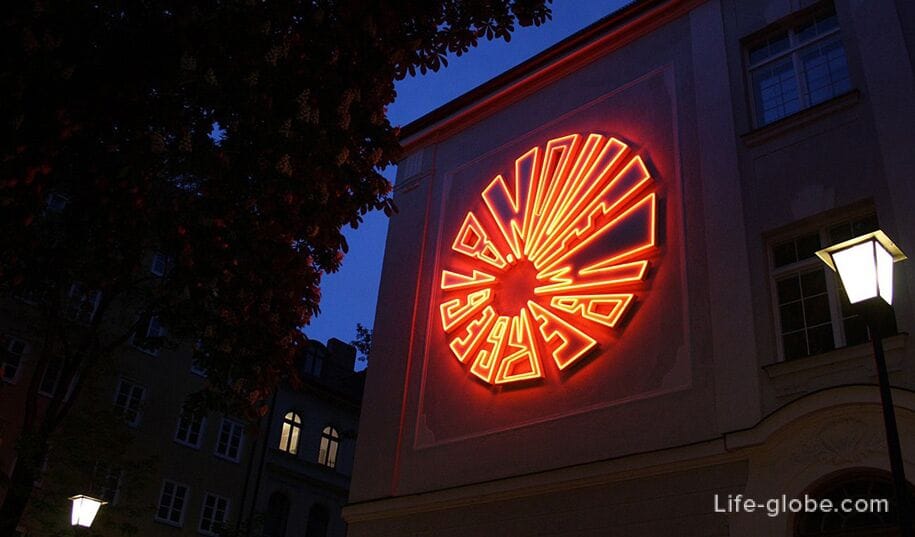
The Turkish Gate (Türkentor) is the only remaining small part of the former Turkish barracks in Munich, built in 1826 for the Royal Bavarian Infantry Rescue Regiment.
In the room there is a sculpture "Large Red Sphere", the work of the American artist Walter De Maria. Admission is free (free of charge).
Address: Turkenstrasse, 17 (Türkenstraße).
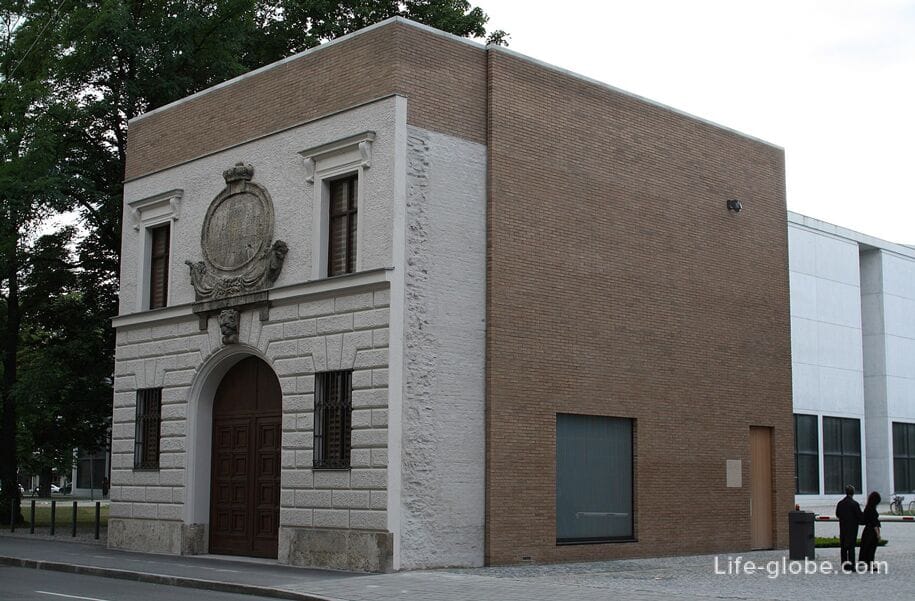

The Palace of Durkheim (Palais Dürckheim) is a building in the classical style with a brick facade, with sandstone elements and reliefs.
The palace was built from 1842 to 1844.
Address: Turkenstrasse, 4 (Türkenstraße).
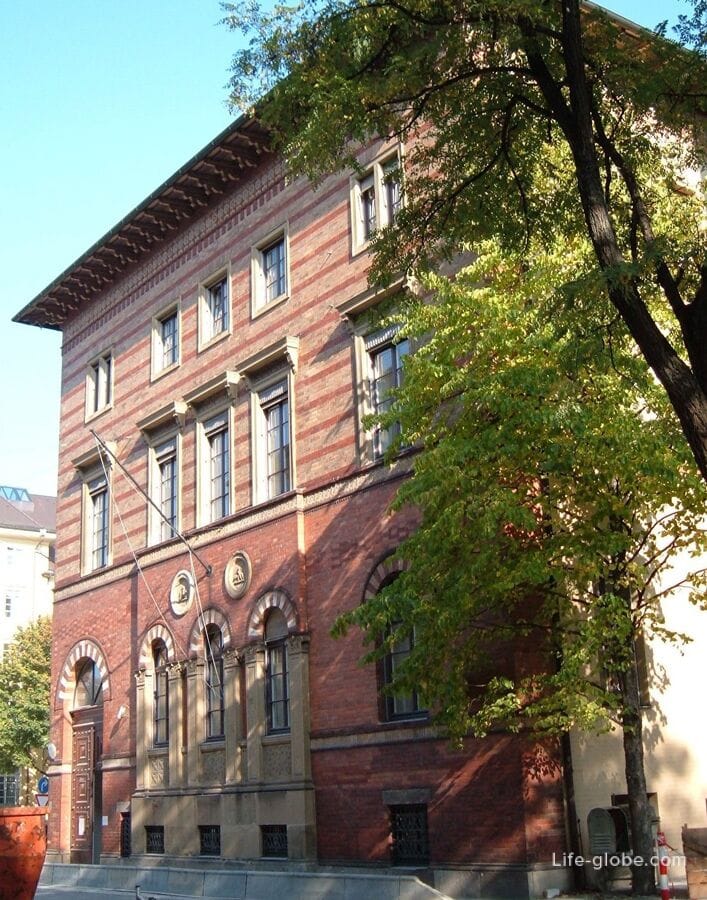
In the center of Munich there are two "palaces of Justice":
- the Palace of Justice (Justizpalast), built in 1890-1897 and attracts attention with its impressive size and unadorned facade.
The architecture of the building is dominated by: four facades, a central glass dome (67 meters) and sculptures located on the facades and roof of the building.
Today, the building houses the Bavarian Ministry of Justice and the District Court I of Munich.
Address: Karlsplatz Square (Karlsplatz) / Prilmeierstrasse, 7 (Prielmayerstraße);
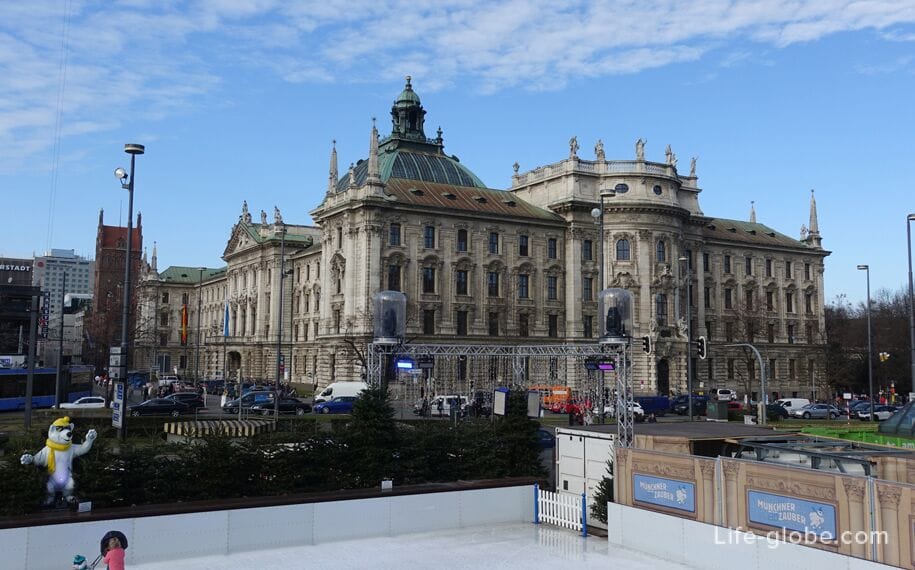

- the new Palace of Justice (New Justizpalast) was built in addition to the already existing palace of justice, because there was not enough space in the latter.
The building was built in 1905, in strong contrast to the "old" Palace of Justice, in red brick in the northern neo-Gothic style with two towers. The end facades are marked by high stepped gables, and the central docking towers on each side are bordered by similar gables.
Today, the building houses the Supreme Regional Court.
Address: Prilmeierstrasse, 5 (Prielmayerstraße).
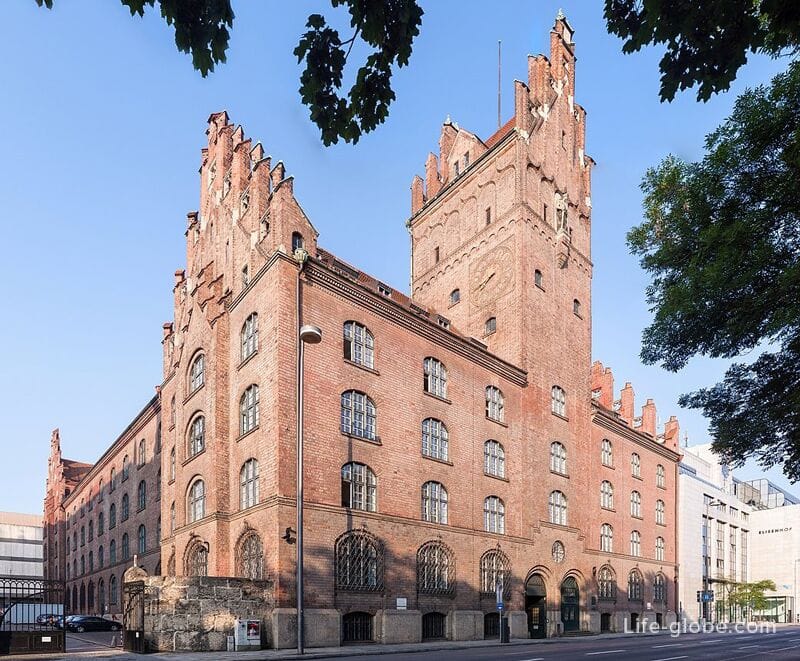
The Löwenbräukeller restaurant is one of the oldest and most famous beer halls in Munich, built by the Löwenbräu brewery.
The building of the pub was built from 1882 to 1883.
In architecture, the buildings are notable: the tower, the painting on the facade and the lion sculpture located above the main entrance.
The restaurant has several halls and a beer garden.
Address: Nimpenburger Strasse, 2 (Nymphenburger Strasse). Restaurant website: loewenbraeukeller.
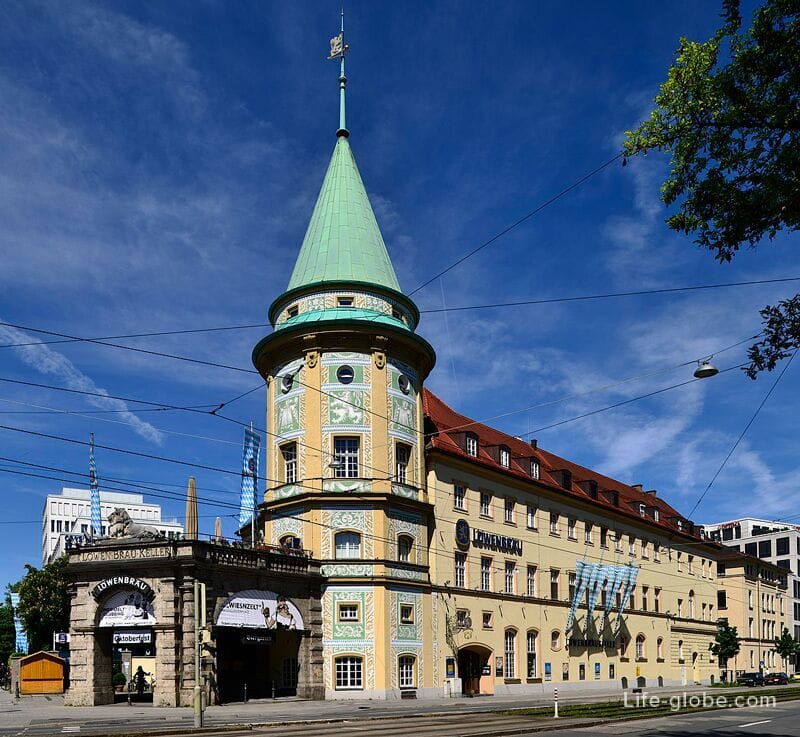
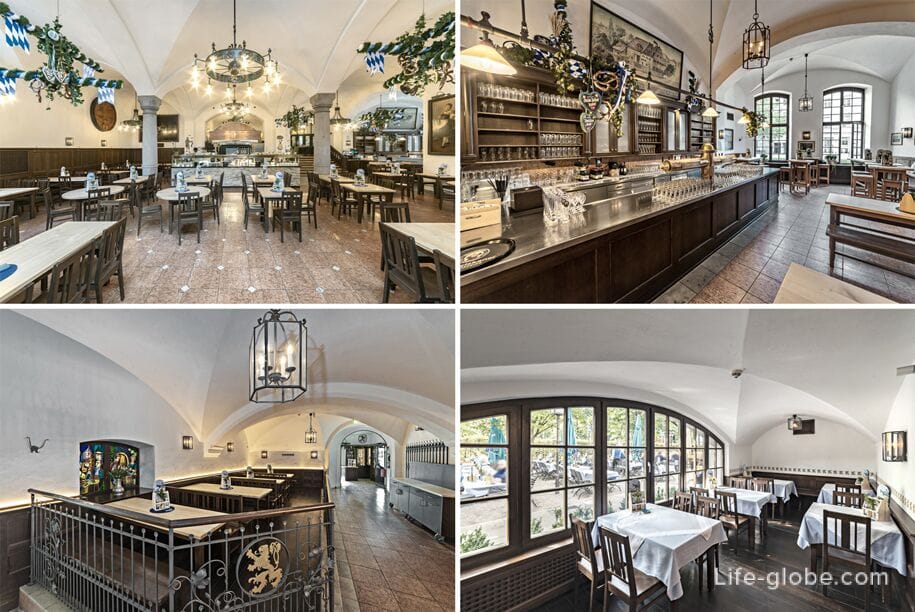
The Isar River flows through the entire city of Munich, in a south-north direction.
On warm summer days, the Isar coast becomes a popular place for picnics and sunbathing. In Izar itself, you can swim, there is a place for surfing. Barbecue facilities are available on the coast. Learn more about holidays on the Isar River in Munich: swimming, barbecue, surfing, walking…
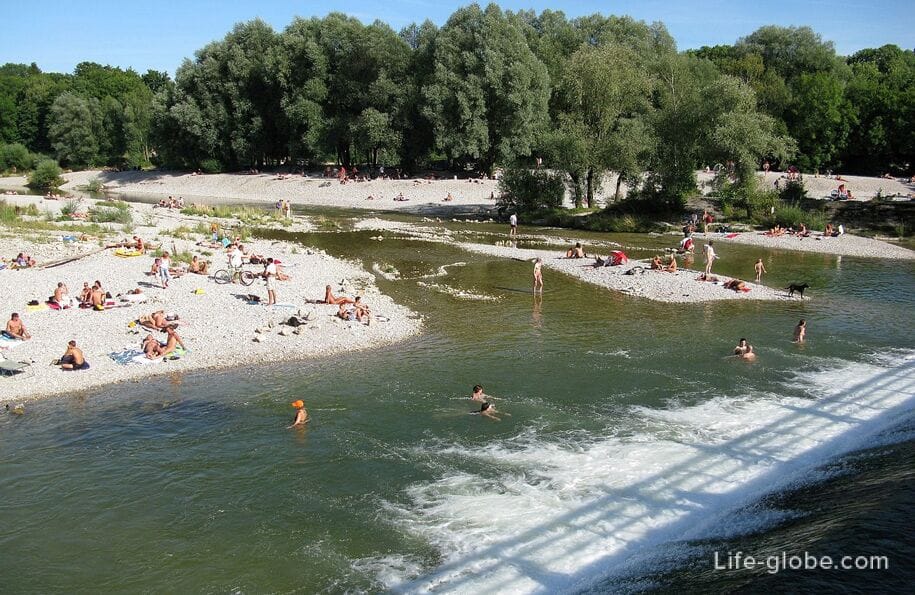
At any time of the year, the banks of the Izar offer visitors and residents of the city places and routes for walking, recreation and some sports (running, cycling, roller skates, etc.).
You can walk along the embankments and parks that run along the river and(or) the numerous bridges across the river that connect the two banks of the river and the islands located on the Izar.
One of the Isar's embankments - Steinsdorfstrasse street (Steinsdorfstraße) and Wiedenmeierstrasse street (Widenmayerstraße) attract visitors with buildings, some of which are historical and architectural monuments. Learn more about bridges and embankments in the center of Munich...

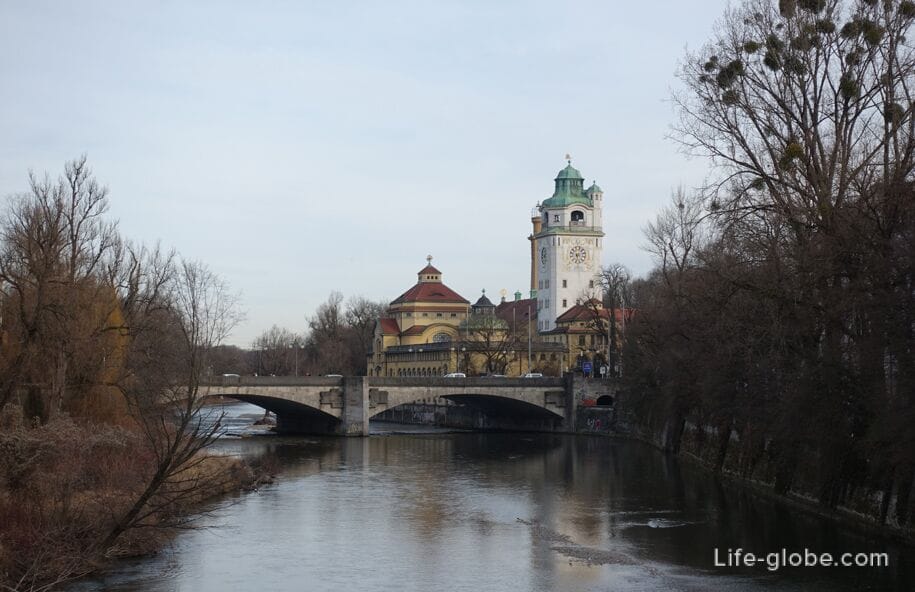
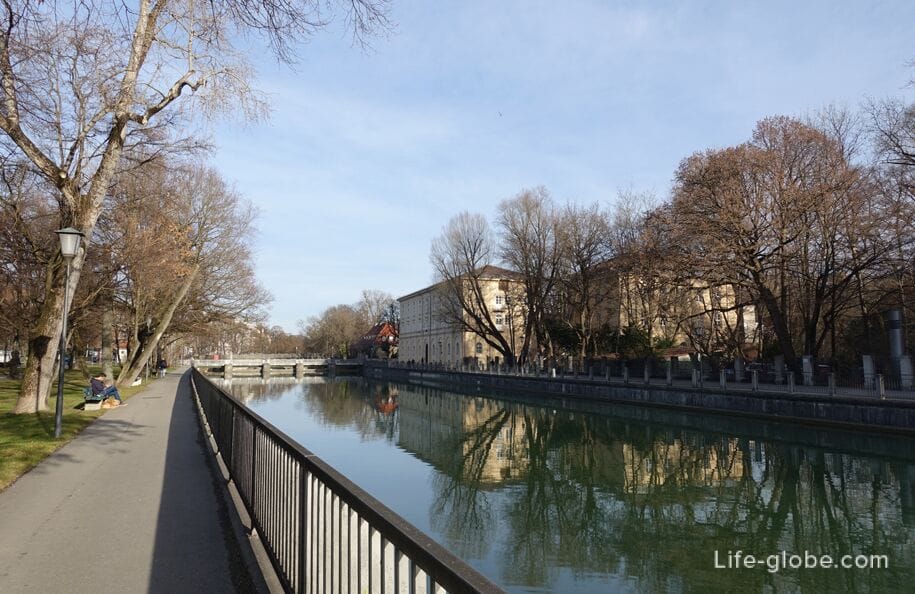

The German Museum of Masterpieces of Science and Technology (Deutsches Museum) is the world's largest and most important science and technology museum, with more than 30,000 exhibits from 50 fields of natural science and technology, from astrophysics to cell biology.
The Deutsches Museum is not only an exhibition space, but also a huge playground where visitors can not only see, but also try out - turning buttons, switching levers and switches, and touching many exhibits.
The German Museum is located on Museum Island (Museumsinsel), at: Museumsinsel, 1.
Museum website: deutsches-museum. Learn more about the German Museum…
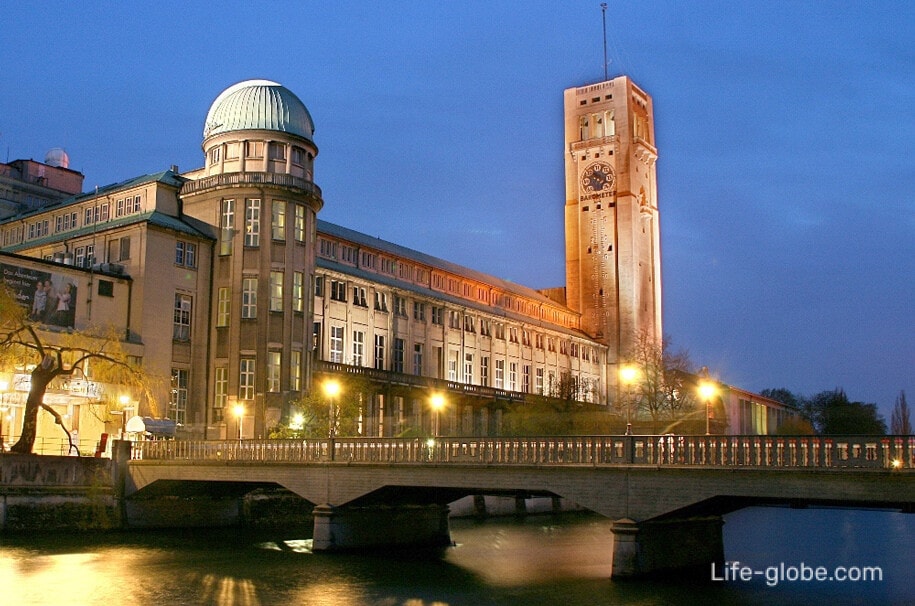
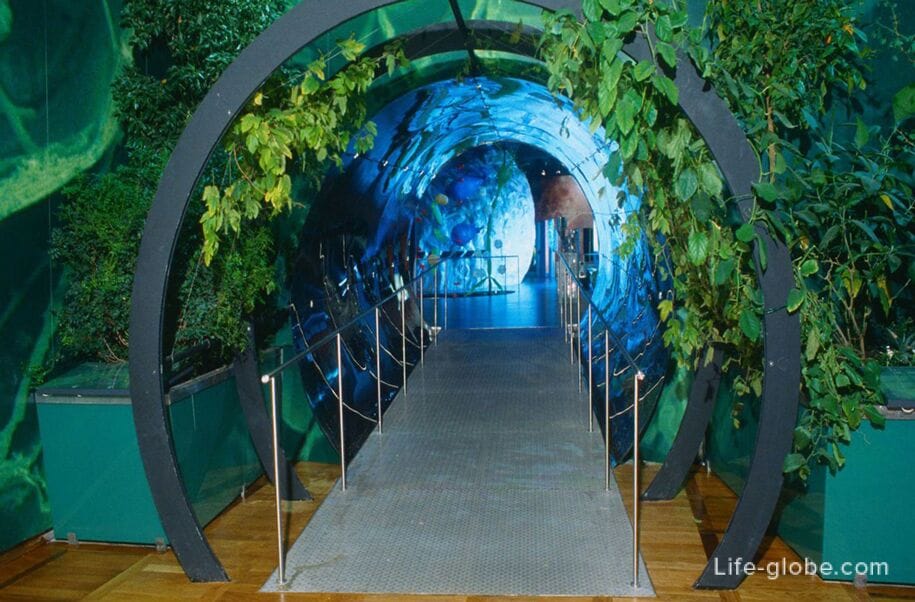
Mueller's city baths were built as a public bath complex with a swimming pool in 1901 in the Art Nouveau style (German Jugendstil) with Baroque elements.
Within the walls of the building are now: two indoor swimming pools, a steam bath with an open courtyard, a bistro, a beer restaurant, massage services and a barber shop.
Address: Rosenheimer starsse, 1 (Rosenheimer Straße). Learn more about Muller baths...

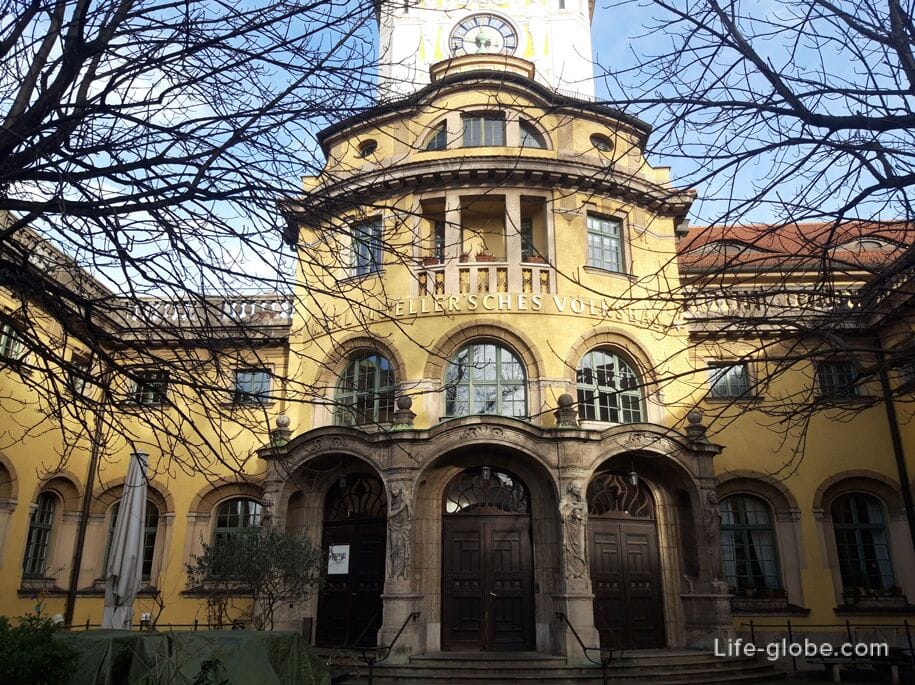
The Church of St. Luke (St. Lukas), also called Lukaskirche - the largest Protestant church in Munich, which is the only almost completely preserved Lutheran church in the historical part of the city.
The shrine was erected in 1893-1896.
Today, this majestic and, without a doubt, architecturally refined building stands on the river bank and attracts attention mainly with its Romanesque features, two tall towers and a large dome.
The interior of the church is based on the early Gothic style.
Church address: Mariannenplatz, 3. More about St. Luke's Church…
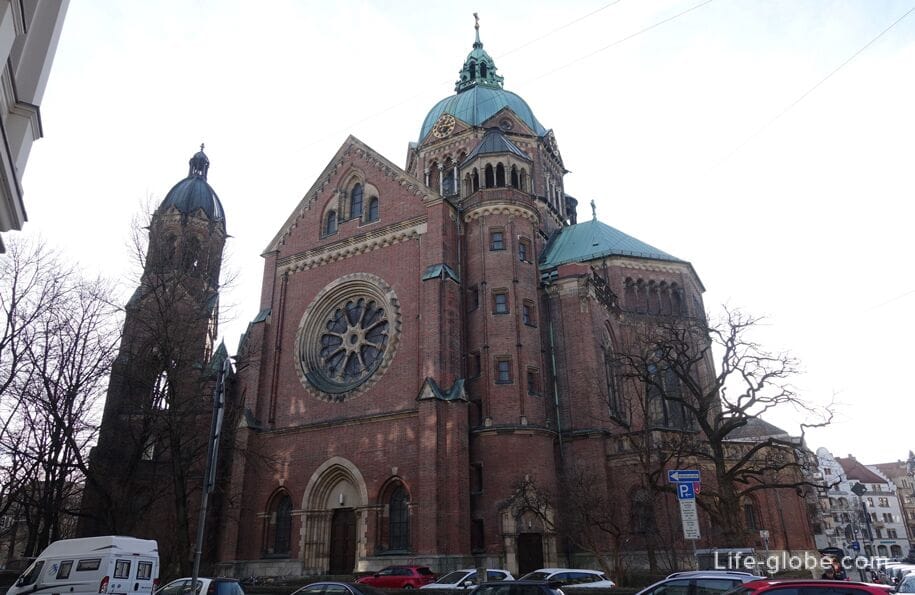
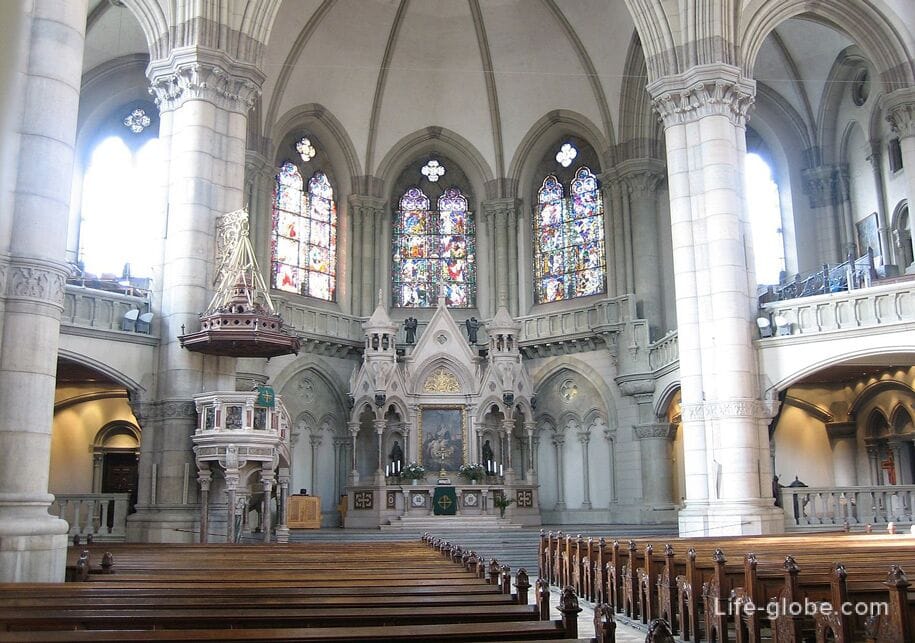
St. Maximilian's Church (Katholisches Pfarramt St. Maximilian, Maximilianskirche) is a Roman Catholic parish church built from 1892 to 1908 in the neo-Romanesque style.
Today, the church is visible from afar thanks to two tall towers, the roofs of which (tower helmets) visually resemble crowns and thanks to which the church stands out favorably against the background of nearby buildings.
Church address: Deutingerstrasse, 4 (Deutingerstraße). More about St. Maximilian's Church...
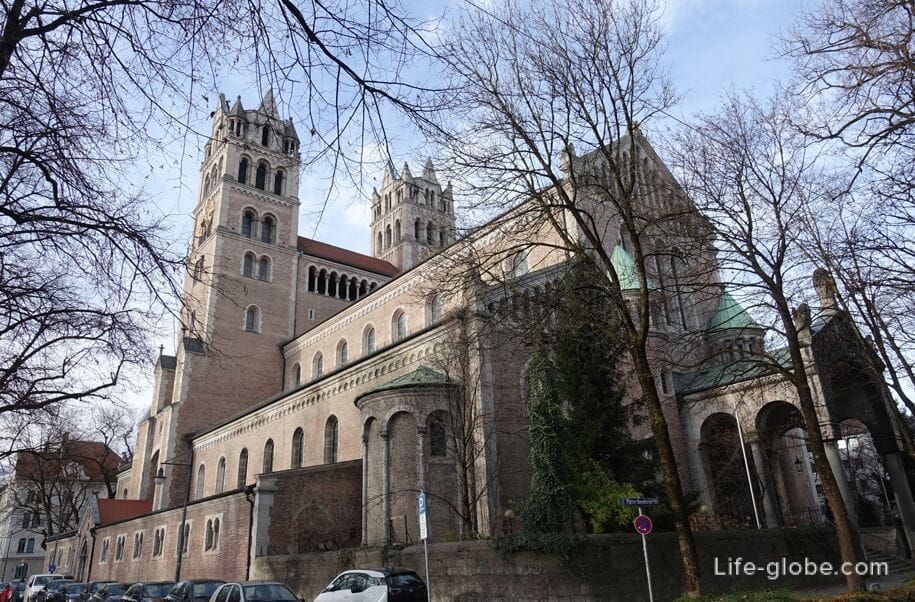
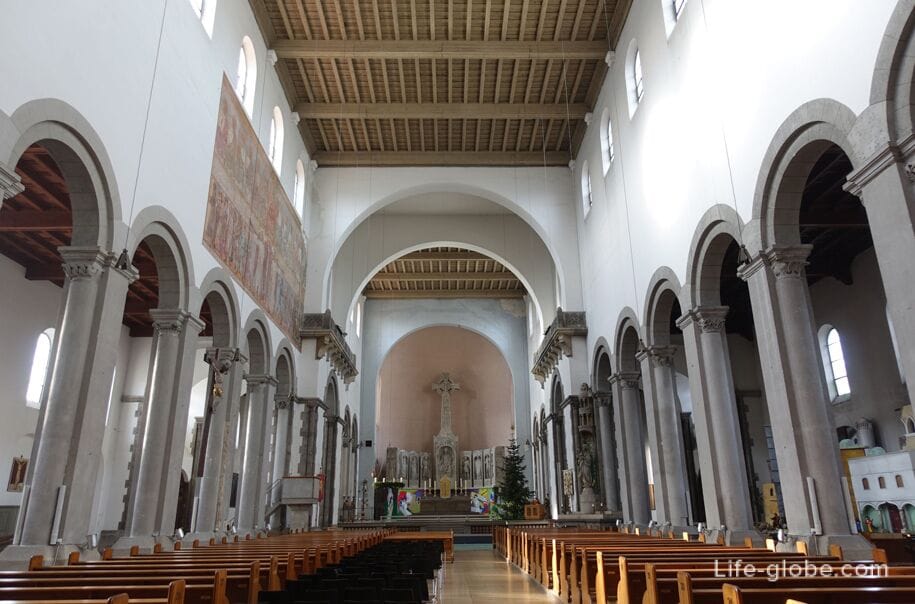
The Hellabrunn Zoo (Münchner Tierpark Hellabrunn) is a geozoo park where animals are housed in spacious enclosures according to their habitat zones: from the Arctic Circle to Africa, from Europe to Asia, and from America to Australia.
In the zoo, more than 750 species of animals live in a natural place in the landscape protection zone of the Isara meadows.
Address of the zoo: Tirparkstrasse, 30 (Tierparkstraße). Zoo website: hellabrunn.
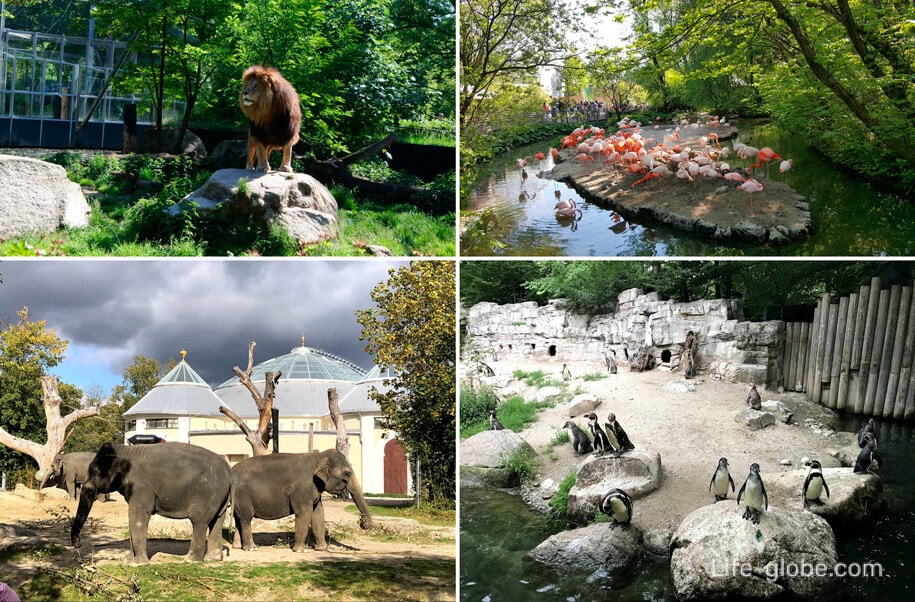
The Botanical Garden Munich-Nymphenburg (Botanischer Garten München-Nymphenburg) is a botanical garden and arboretum that was established in 1914.
Today, more than 19,000 species and subspecies of plants are grown in the garden, and it also serves to preserve rare plants and European bee species.
The main areas of botsad include: alpine garden, arboretum, collection of marsh and steppe plants, rhododendrons, rose garden, systematic garden, aquatic plants in aquariums and an extensive greenhouse complex.
Garden address: Menzinger Str. 65. Botsad website: botmuc.
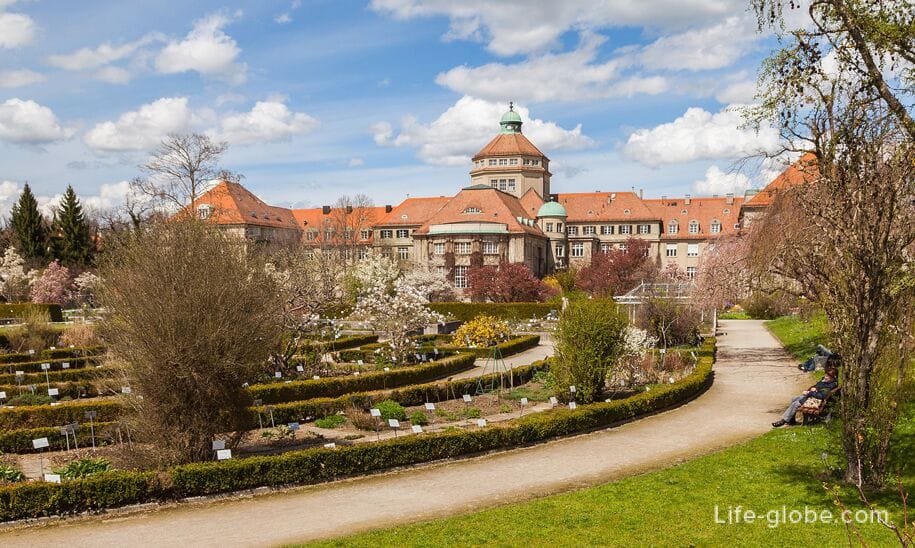

Vienna Square (Wiener Platz) is one of the most charming and controversial squares in Munich.
On the square from 1889 to the present day, there is a small permanent food market. The market in the square is open every day except Sunday.
Also notable on the square are: "Maypole", historical buildings, restaurant "Hofbräukeller" with a beer garden and the Fischerbuberl-Brunnen fountain, in the upper central part of which a naked boy in a panama hat is depicted standing on a ball and holding a fish in each hand. Learn more about Vienna Square…
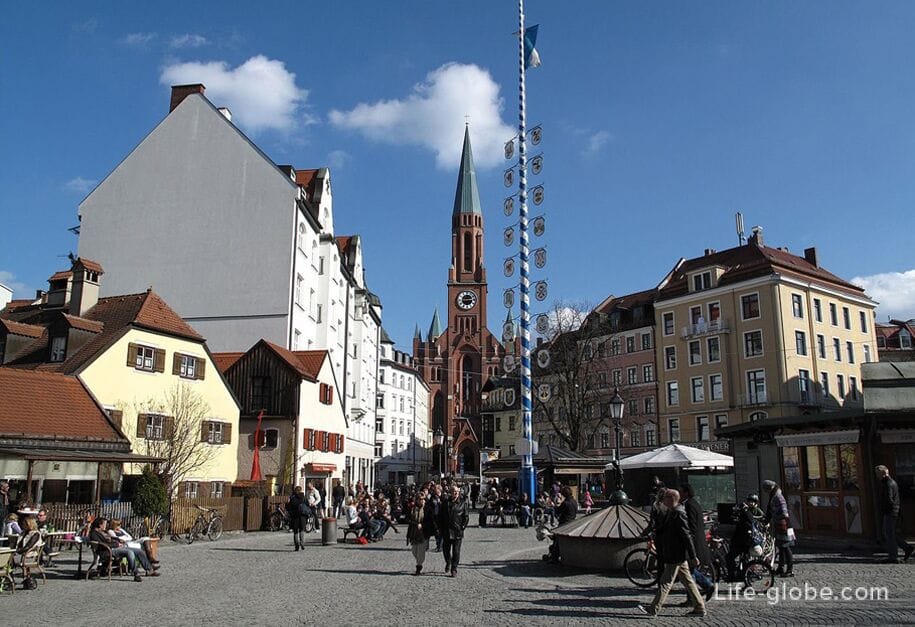
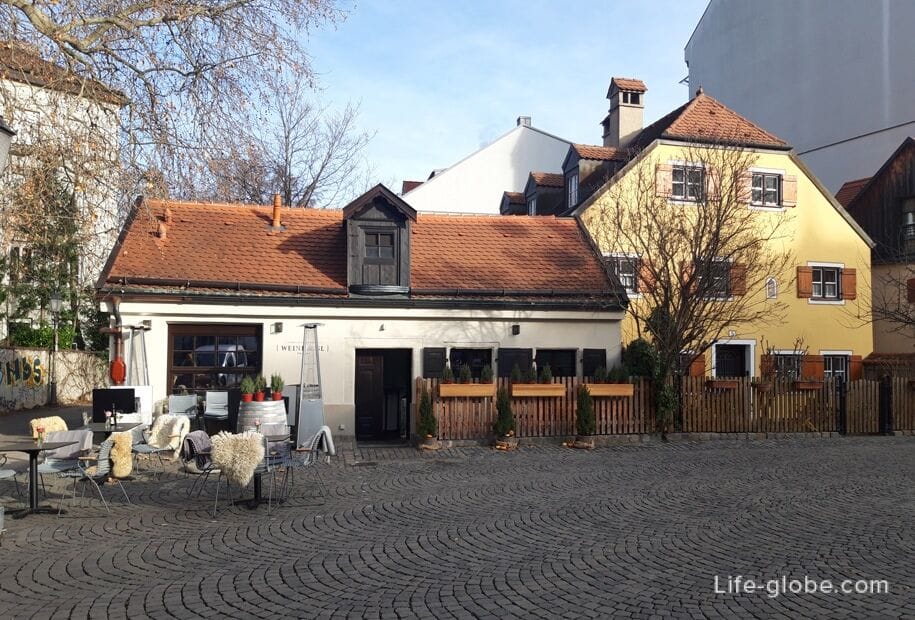
Weissenburger Square (Weißenburger Platz) forms the center of the so-called "French Quarter", which was created in 1872 after the German victory in the Franco-Prussian war (1870-1871).
In the center of the square is the "glass palace fountain" (Glaspalastbrunnen), created by August Voight in 1853. The fountain was once located in the Glass Palace (now defunct) in the old Botanical Garden of Munich, but was later moved to its current location.
In the warm season, flowers are planted on the square, and guests and locals relax on the benches. On Christmas Eve, there is a small and cozy Christmas market in the square.
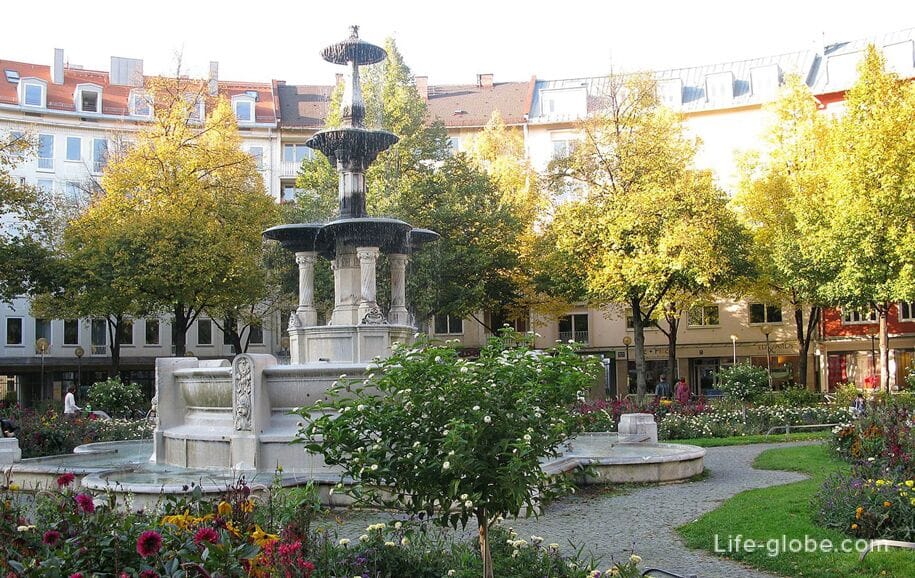
The new parish church of St. John the Baptist (Pfarrkirche St. Johann Baptist) was built between 1852 and 1874 in the neo-Gothic style. This church replaced the already old and smaller church Haidhausen district, which did not have enough space for parishioners.
The west tower of the church is more than 90 meters high, making the shrine one of the tallest churches in Munich.
The neo-Gothic marble main altar, the tall stained glass windows, the side altars, the communion pew and the organ attract special attention in the interior of the church.
Church address: Johannisplatz. More about St. John the Baptist Church…
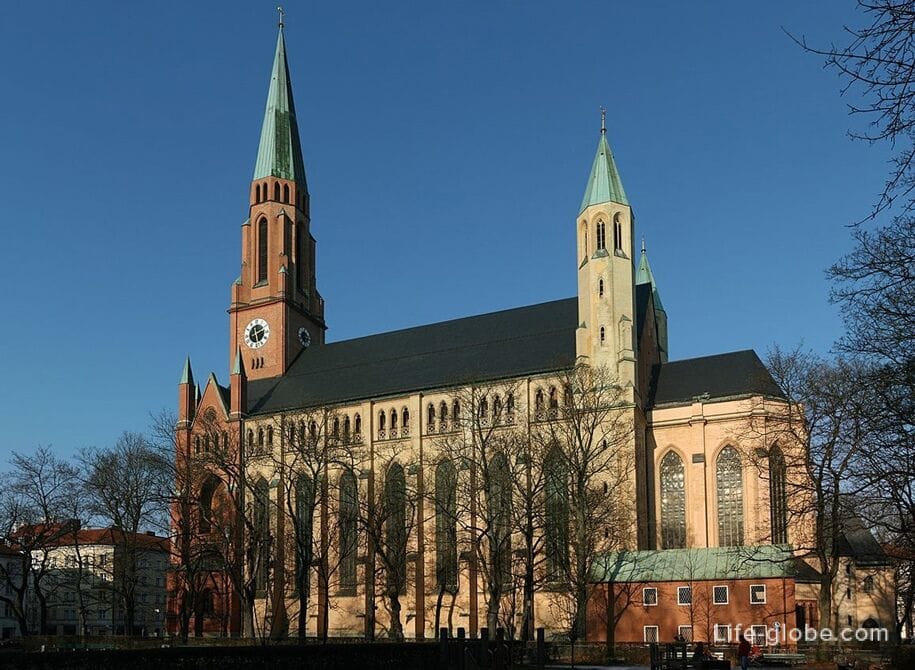
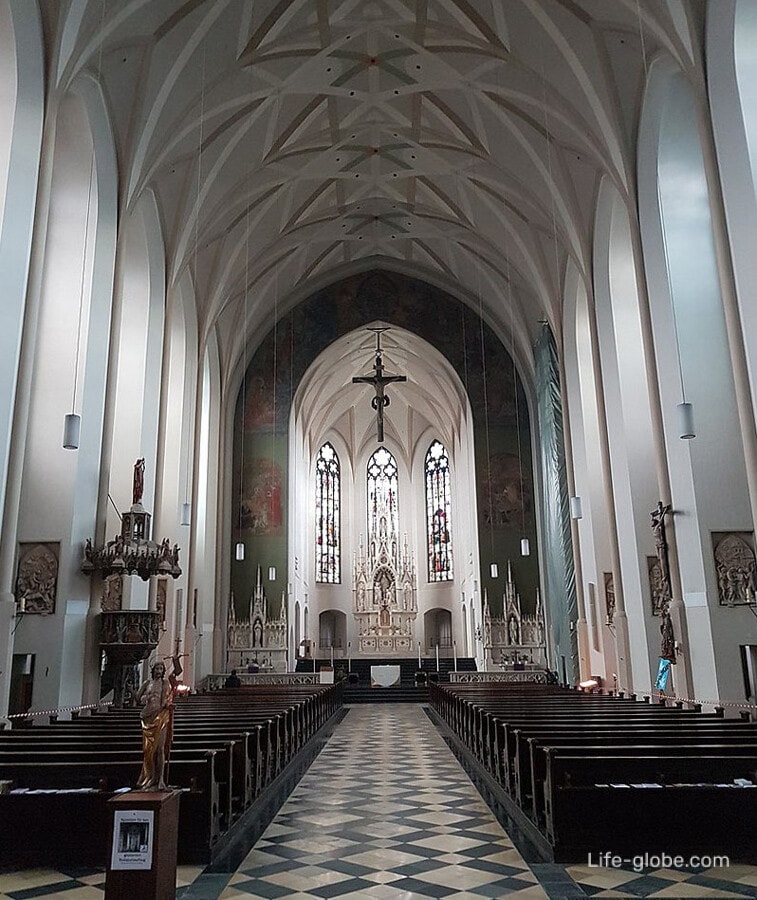
Mariahilfplatz is famous primarily for the fact that three times a year it hosts one of the largest traditional fairs in Munich - "Auer Dult" (translated: "valley fairs"): in spring in May (Mai-Dult), in summer in July or early August (Jakobi-Dult) and in autumn in October (Kirchweih-Dult).
The center of the square is dominated by the Neo-Gothic Catholic parish Church of Mariahilf (Mariahilfkirche), which was built from 1831 to 1839 and is considered an example of a 19th-century neo-Gothic church building.
The church has a high tower, reaching 93 meters. There is an organ in the church.
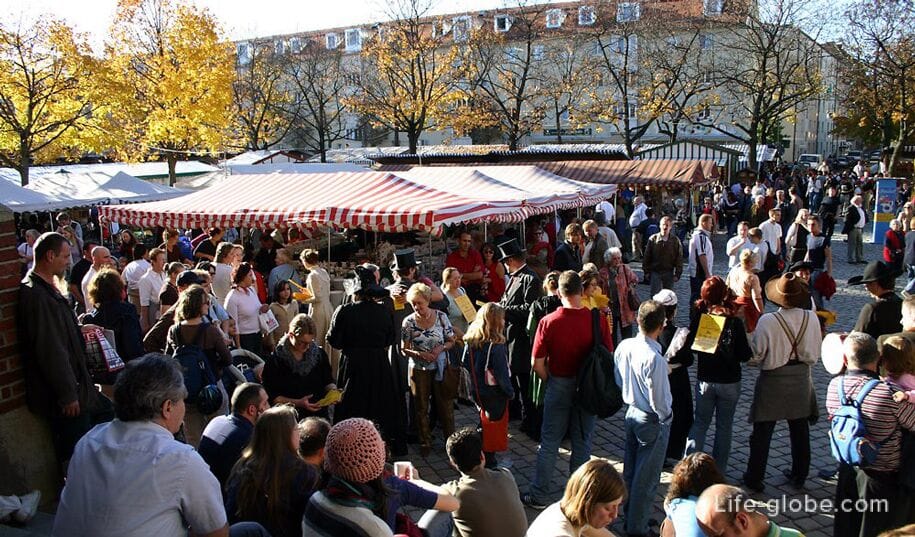
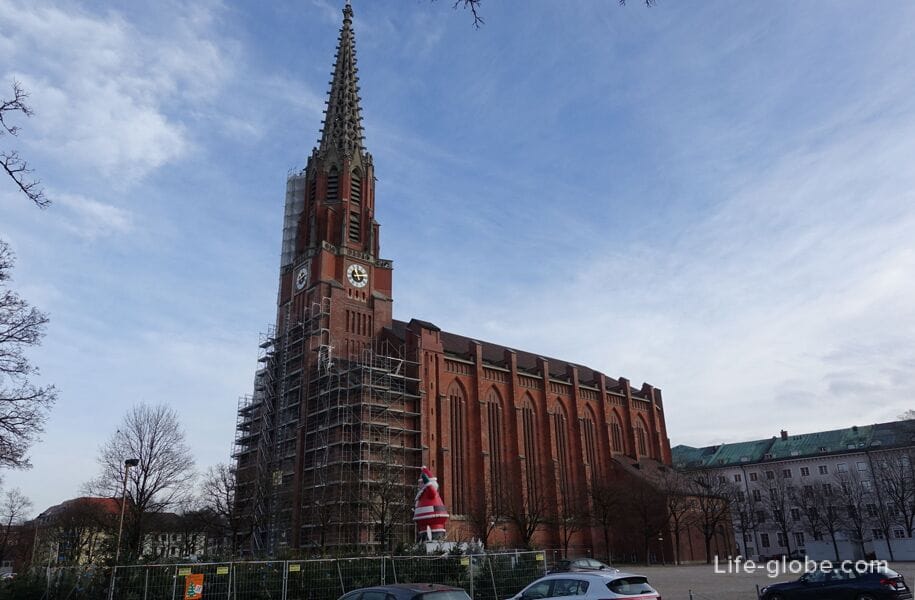
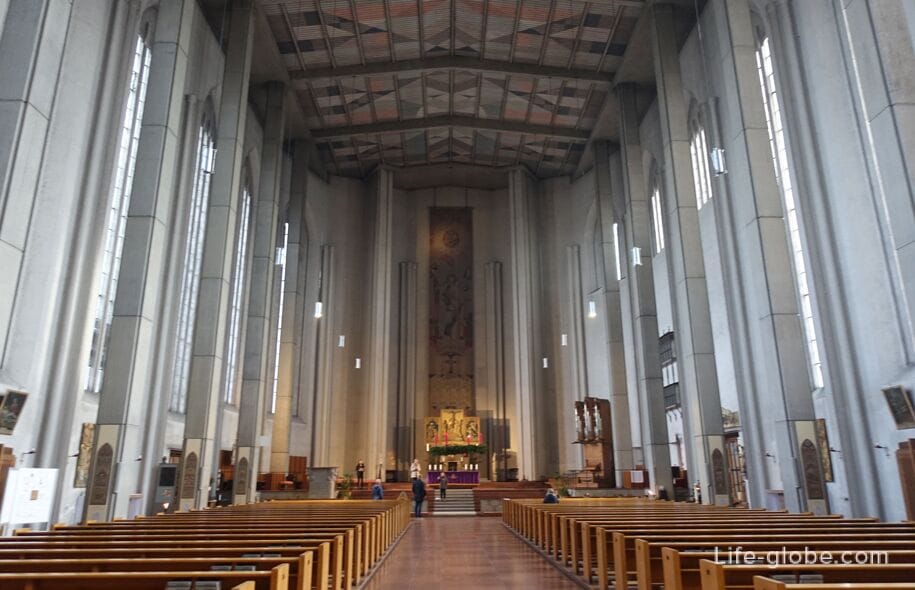
St. Anne's Square (St.-Anna-Platz) is considered the center of the district of Lehel and was created in the late 19th century as part of the construction of the new parish church of St. Anna (Pfarrkirche St. Anna).
The Church of St. Anne, located in the center of the square, was built in the neo-Romanesque style in 1887-1892.
This church is considered one of the best examples of historicism in Munich.
Inside the church, the apse fresco above the main altar, created by the German artist and craftsman Rudolf von Seitz, is noteworthy.

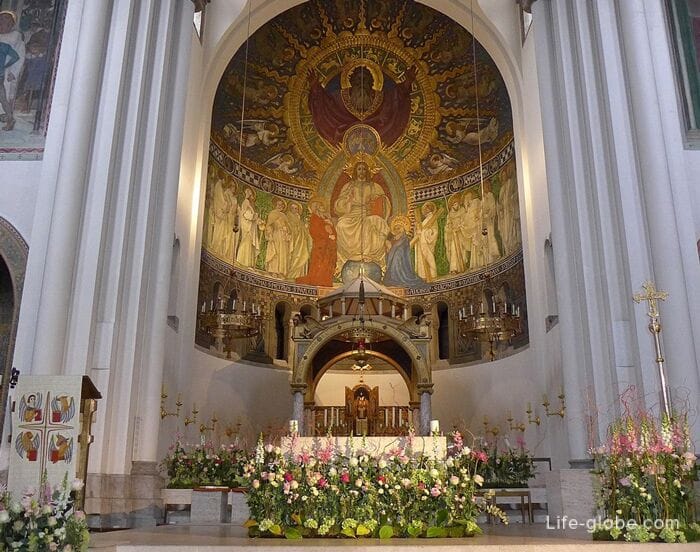
Across St. Anna Street (St.-Anna-Straße) from the church of St. Anna is the eponymous monastery church of St. Anna (Klosterkirche St. Anna), which is the first church built in the Rococo style in Old Bavaria.
The construction of the church began in 1727 as a sign of gratitude for the birth of the heir to the Bavarian crown, Maximilian III.
The church is notable: frescoes, main altar, pulpit and organ.


The Round Gertner Square (Gärtnerplatz) was built around 1860 and named after the German architect Friedrich von Gertner.
In 1865, in the southern part of the square was erected theater on Gärtnerplatz (Staatstheater am Gärtnerplatz) in the late classical style, which still forms the appearance of the square.
In the center of the square are: Schalenbrunnen fountain, monument to the architect Leo von Klenze (1784-1864), flower beds and recreation areas.
In the buildings around the square there are retail premises, cafes and restaurants.
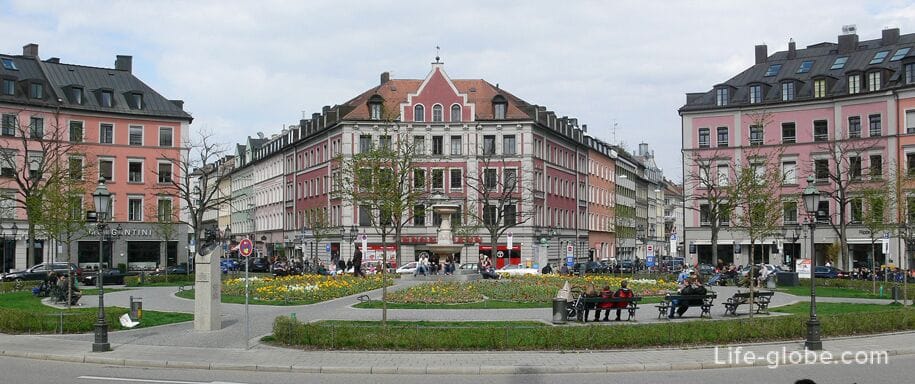
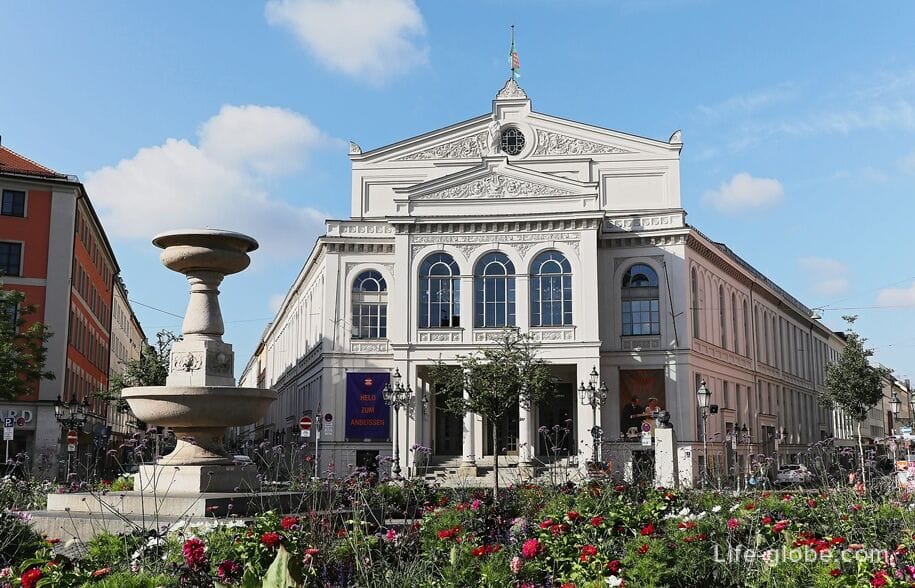
Near the historic city center, in in the Ludwigsforstadt-Isarforstadt district, there is the Teresa's meadow (Theresienwiese), which is the largest venue in Munich for celebrations and festivals, including:
- the world's most famous and largest folk festival (beer festival) - Oktoberfest, which is held annually from the second half of September to the beginning of October;
- in winter (December), on the eve of Christmas and New Year's Eve, the Tollwood festival is held in Teresa's Meadow, which includes a Christmas market and cultural events that are held until the New Year's Eve. Learn more about Teresa's Meadow and the festival...
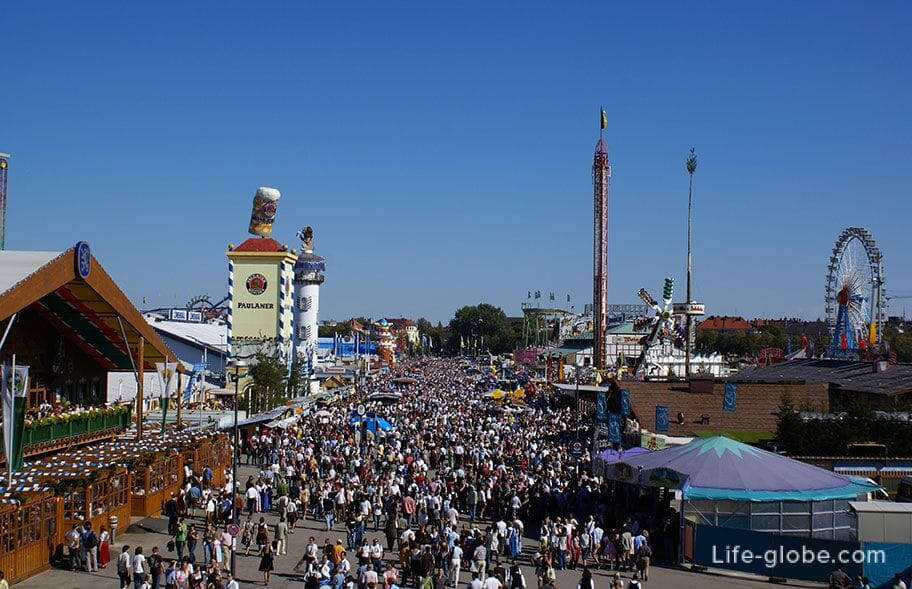
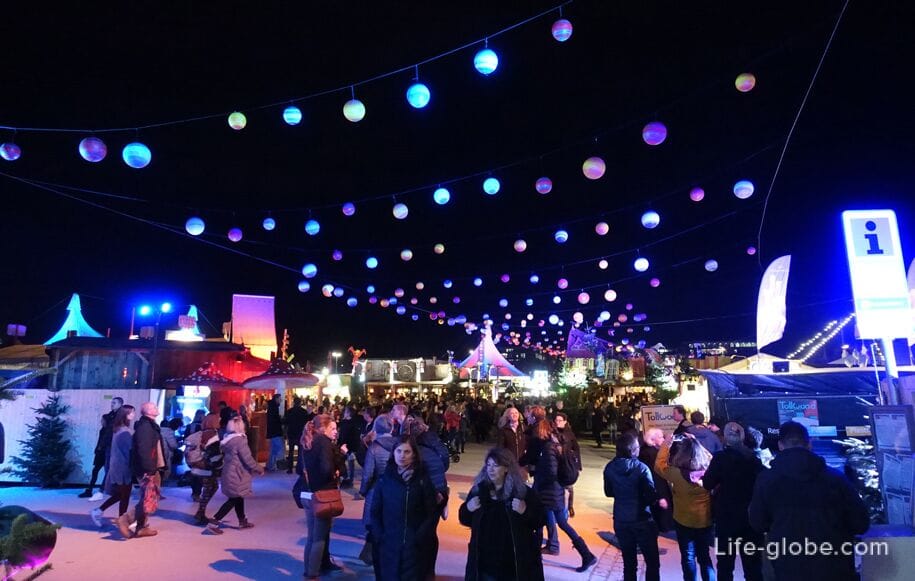
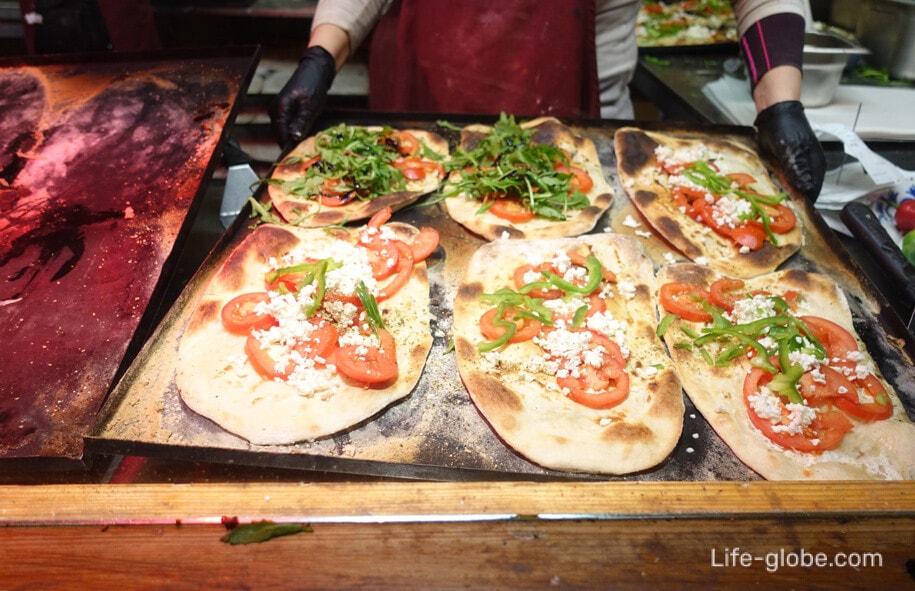
The Statue of Bavaria (Bavaria Statue) is a monumental bronze statue that, in its female form, represents the Bavarian region - its strength and glory. The statue was commissioned by King Ludwig I of Bavaria and made from 1844 to 1850.
An internal spiral staircase, located in Bavaria, leads to a platform at the head of the statue, from where small openings overlook the Therese Meadow and the surrounding area.
The Hall of Fame (Ruhmeshalle mit Bavaria) is a monumental structure that, like the statue "Bavaria", was commissioned by King Ludwig I of Bavaria and erected between 1843 and 1853.
The purpose of the construction was to honor the memory and glory of the outstanding personalities of Bavaria.
The Hall of Fame is located behind the statue of Bavaria and is a gallery with busts of famous Bavarians of past centuries.
Address: Theresienhöhe, 16. Learn more about the Bayern Statue and Hall of Fame…
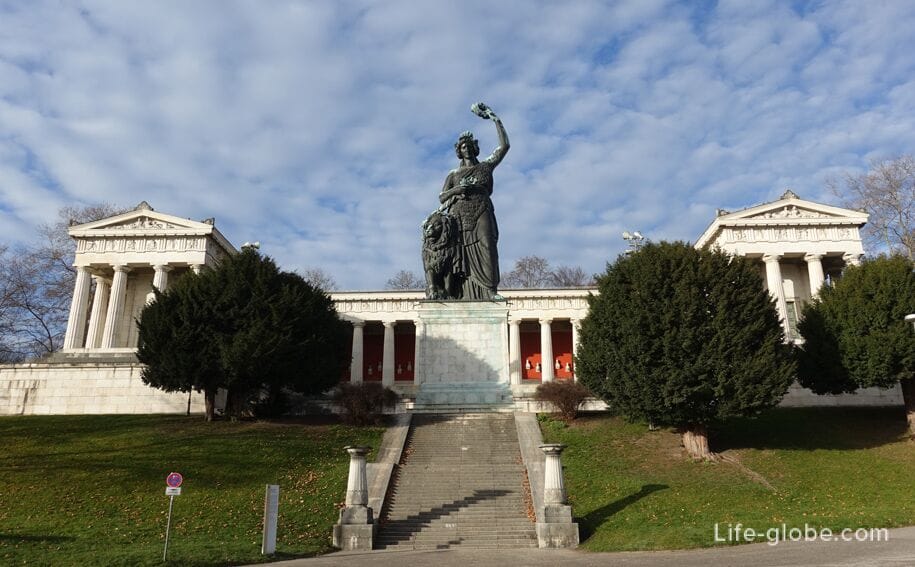

The Church of St. Paul (Kirche St. Paul, Paulskirche) was built between 1892 and 1906 in the neo-Gothic style.
Special attention is drawn to the church by the high main tower, which rises to the sky at 97 meters and at the top of which there is a circular observation deck with views of the Therese Meadow, the center of Munich and the surrounding area. The site is open to visitors during the Oktoberfest.
Address: St. Paul's square, 11 (St.-Pauls-Platz). More about St. Paul's Church...
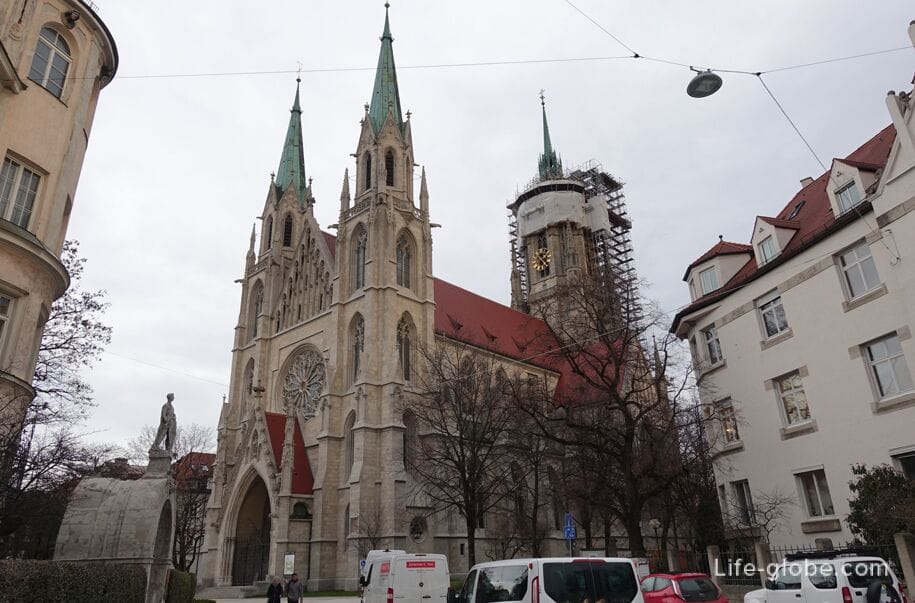
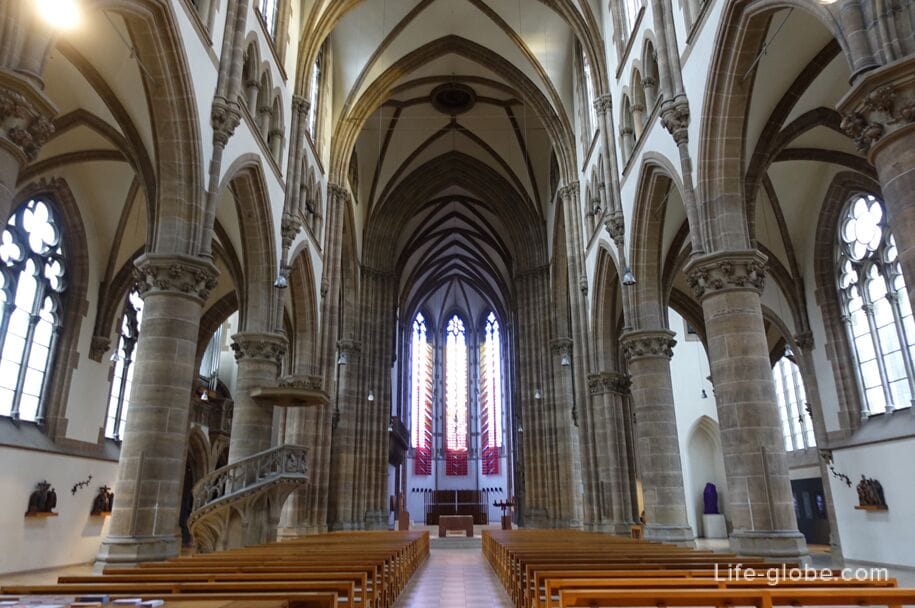
Park West (Westpark) is a large urban public park created for the International Horticultural Exhibition (IGA) in 1983.
In the park: two lakes, cafes and beer gardens, playgrounds and sports fields, fountains, sculptures, recreation areas, walking and cycling paths, a rose garden where 20,000 roses (500 different types) bloom in spring, an East Asia ensemble with gardens and buildings, and a stage area (Seebuhne) where summer open-air film screenings, live music concerts and theatrical performances take place.
The park has designated areas for grilling (barbecue).
On snowy winter days, you can go sledding in the park.
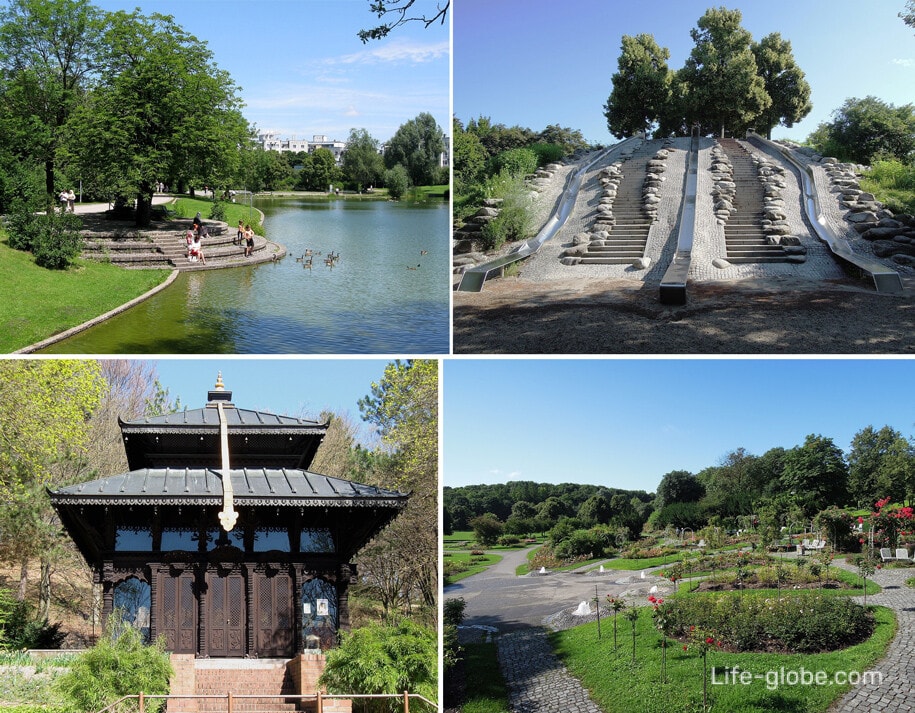
In 1911, the Bavarian Prince Regent Luitpold turned 90 years old. In his honor, 90 lime trees were planted, around which a public park was later created - so the Luitpold Park (Luitpoldpark) was born.
In the park: places for recreation and walking, a fountain, an obelisk, playgrounds, the historic neo-arched building "house of Bamberg" (Bamberger Haus) in the walls of which there is now a restaurant with a summer terrace.
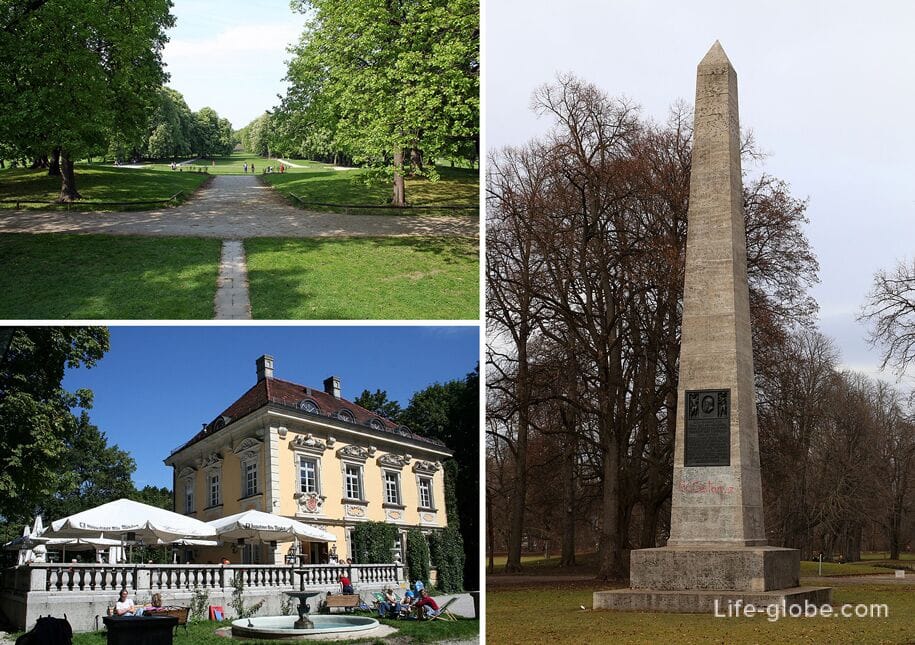
The most visited place in the Luipold Park is the 37-meter Luitpold hill (Luitpoldhügel), which has an artificial origin and on top of which there are places for recreation and a green observation deck with views of the park itself and partly of Munich and the surrounding area.

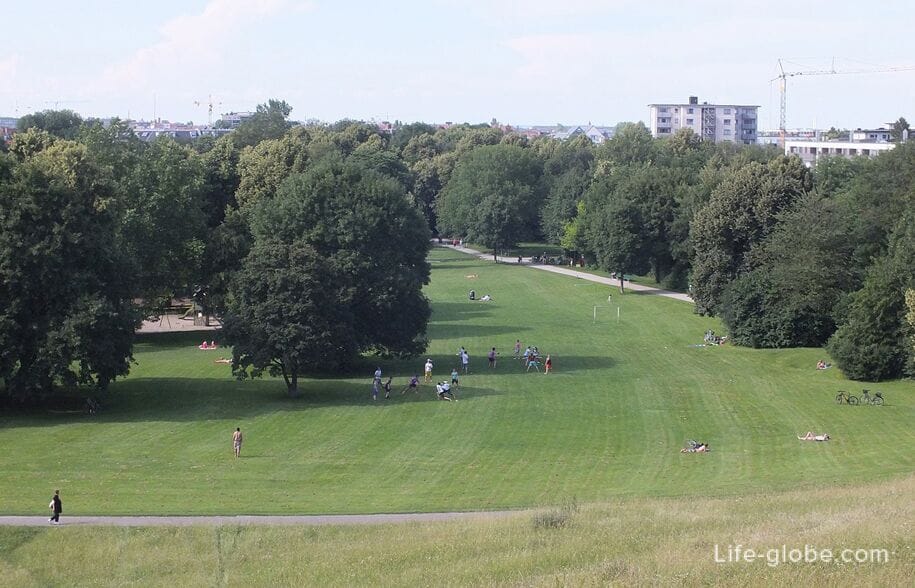
Hirschgarten Park, which means "Deer Garden", is located in the western part of Munich, near the Nymphenburg Palace.
The name "Deer" park was given because it was previously located outside the city and nobles hunted in this area. In 1780, Elector Karl Theodor ordered the creation of hunting grounds: part of the territory was fenced, and 100 pairs of red deer were released.
In 1958-1959, the north-eastern part of the park was transformed into an urban recreation area. From 1968 to 1970, the area was expanded to the south and became a public park.
Today, Hirschgarten is a public park which contains: trees, some of which are more than 150 years old, playgrounds, a skate park, meadows, barbecue areas and a 2-hectare aviary with fallow deer and moufflon.
Also in the park is supposedly the largest beer garden in the world, designed for 8000 seats. Однако не совсем ясно, действительно ли пивной сад в парке является самым большим в мире?! Но одно можно сказать наверняка: «по крайней мере, в Баварии нет пивного сада, который может похвастаться большим количеством мест». Сайт ресторана с пивным садом: hirschgarten.
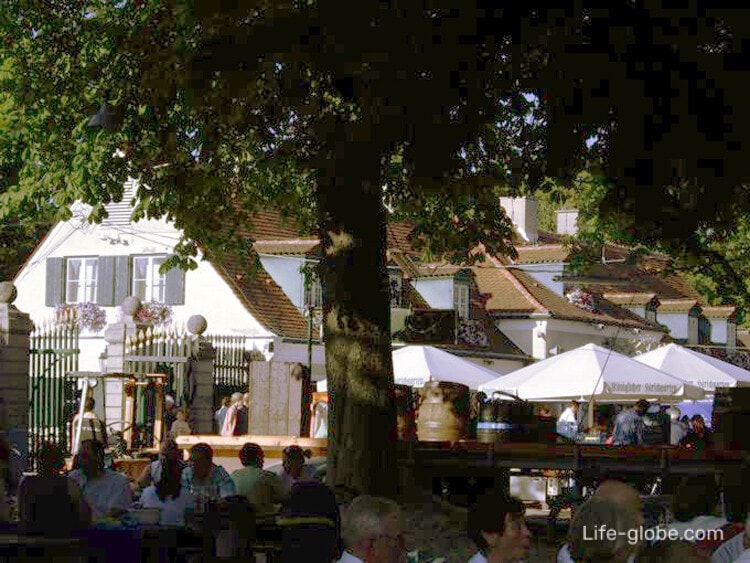
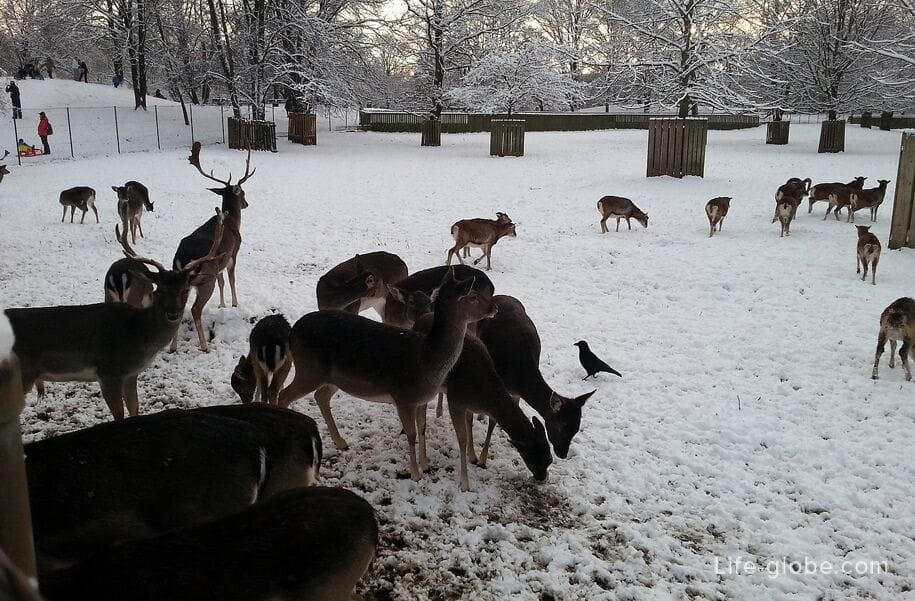
Blutenburg Castle (Schloss Blutenburg) was built on the site of fortifications that existed in the 13th century, as an old ducal house.
The castle was built for Duke Albrecht III of Bavaria in 1438-1439 as a hunting lodge, replacing the old castle that burned down during the war.
Today, the remains of the castle are preserved: the residential tower, part of the ring wall with towers, some rooms and the palace chapel - a late Gothic masterpiece, which still has stained glass windows, a cycle of statues of the apostles from 1490-1495, and altars with three paintings created in 1491 by Jan Polak.
Throughout the year, the castle and the surrounding area host festivals, festivals and other events, including the Christmas market.
Address of the castle: Seldweg, 15. Castle site: blutenburg.
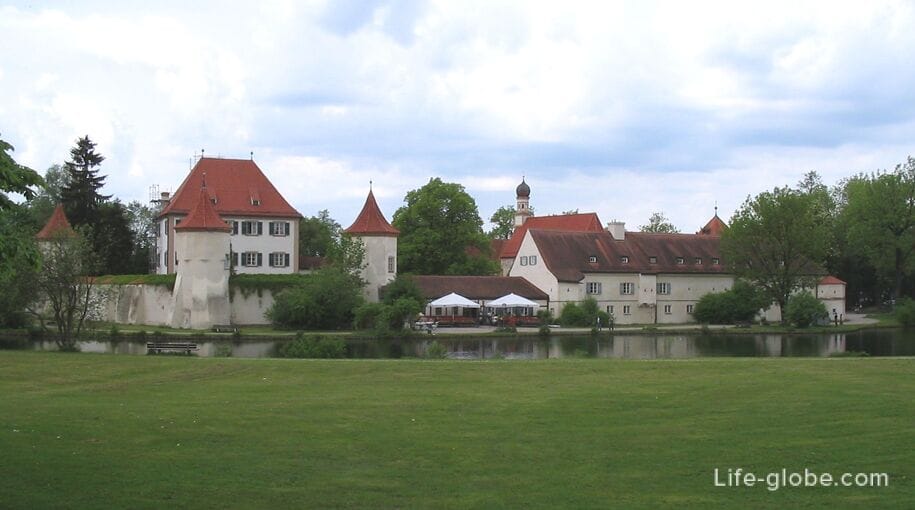
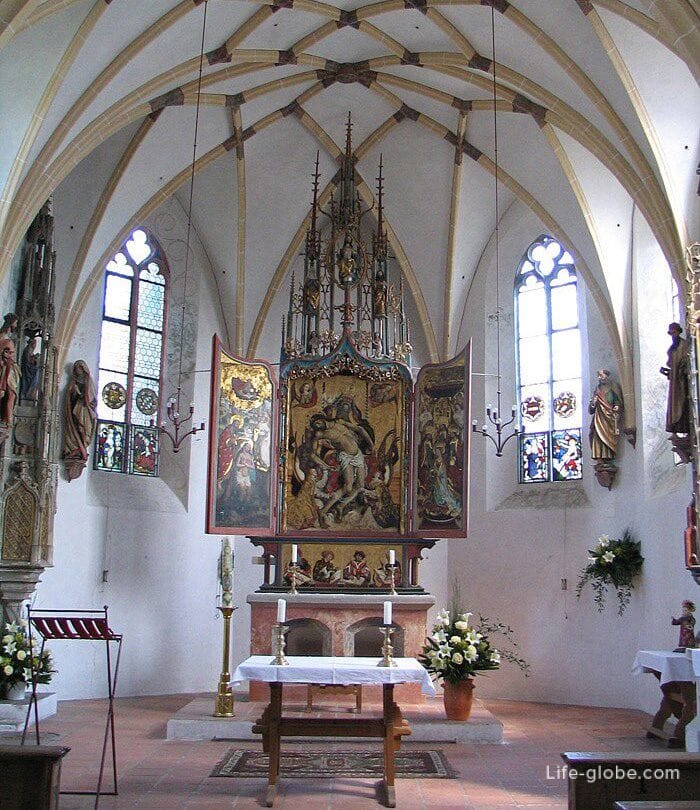
The Allianz Arena is a football stadium and the home ground of the FC Bayern Munich football team, which hosts both local and international matches.
The stadium is widely known for its appearance of "air" plastic panels, thanks to which the Allianz Arena is often called "inflatable boat" (Schlauchboot), "car tire" (Autoreifen) and "air cushion" (Luftkissen).
The Allianz Arena was opened on 30 May 2005 with a friendly match between Munich 1860 and Nuremberg.
The Allianz Arena is located in the north of Munich, at: Werner-Heisenberg-Allee, 25. Site: allianz-arena.
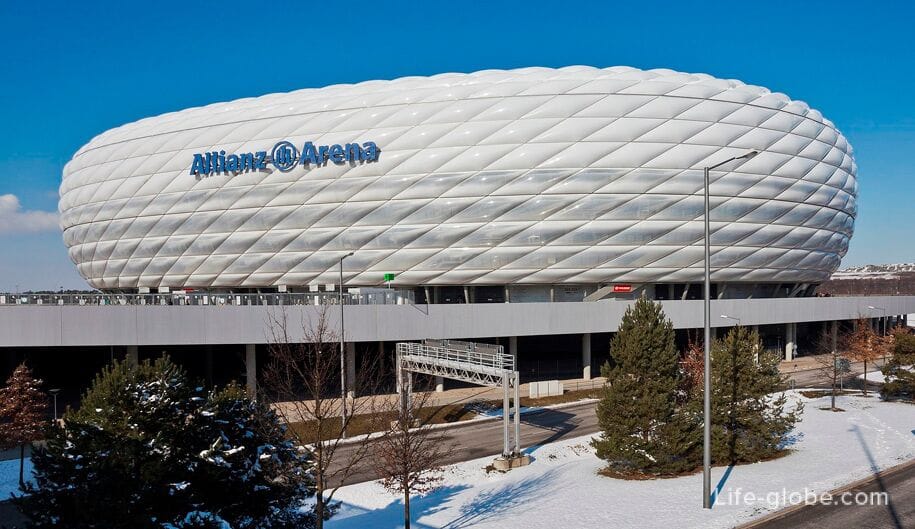
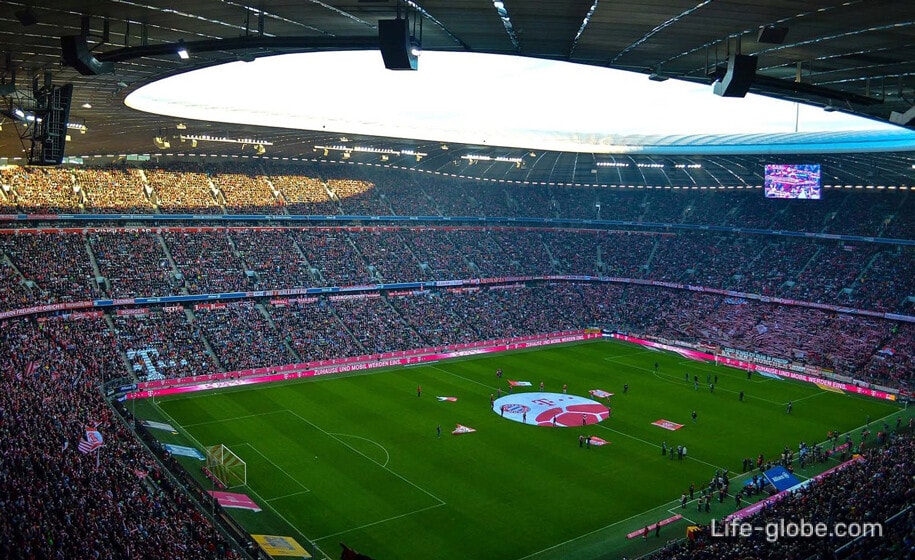
Within the walls of the stadium is the museum of FC Bayern (FC Bayern museum), which is the largest museum of a football club in Germany.
The museum tells the story of FC Bayern - from the moment the club was founded in 1900 and up to the present day.
You can purchase a separate ticket to the museum or a combined ticket (Kombitiket), which includes a visit to the museum and a tour of the Allianz Arena itself. Museum website: fcbayern.com/museum. Learn more about the stadium and the museum...

Near the stadium are the meadows of the Frettmaning hill (Fröttmaninger Berg), which has an artificial origin and a height of 75 meters.
Within the hill are places for walking and relaxing, a children's playground and a wind turbine, and from its top you can enjoy views of the football arena, the Munich skyline and the surrounding area.
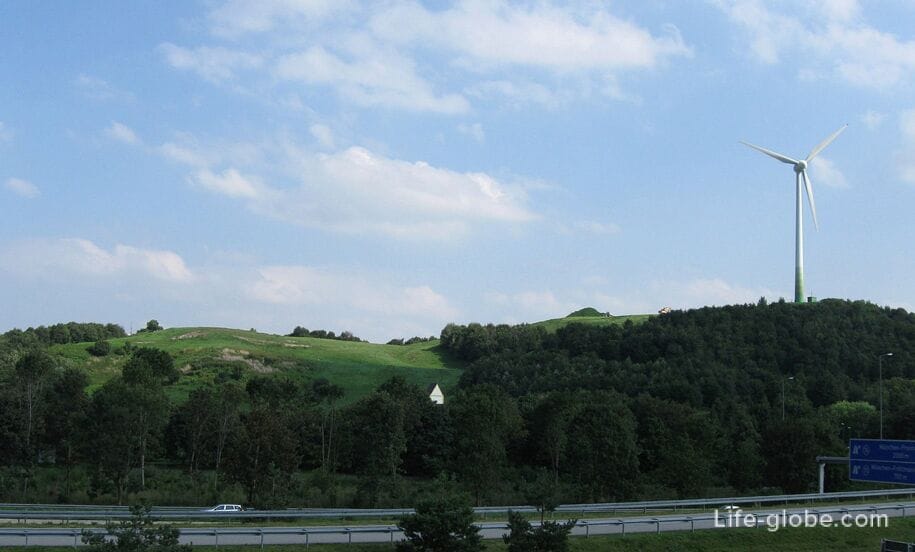
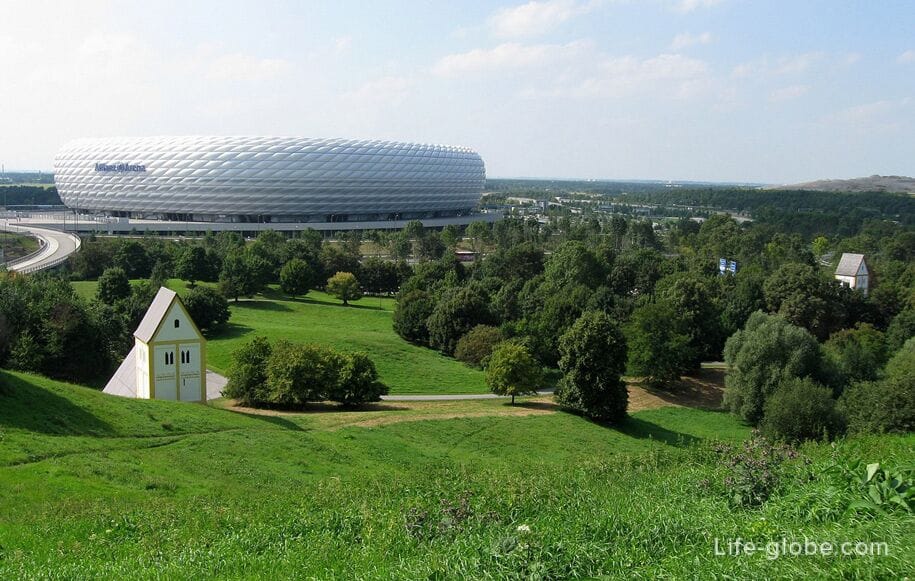
The Old Southern Cemetery (Alter Südfriedhof) is the oldest surviving central cemetery in Munich, which was formed outside the city during the plague in 1563.
Today, the cemetery is not used for its intended purpose (for burials), but is a kind of park.
Within the cemetery are located: old graves, including a number of prominent Munich residents, the cemetery church of St. Stephen (Kirche St. Stephan), a playground, a fountain and a lapidarium (Lapidarium, former sanctuary).
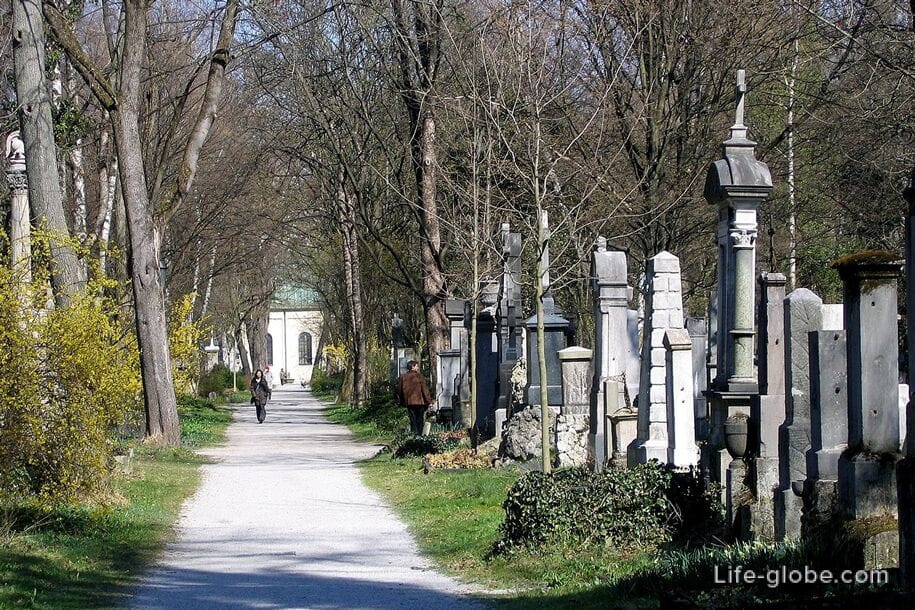
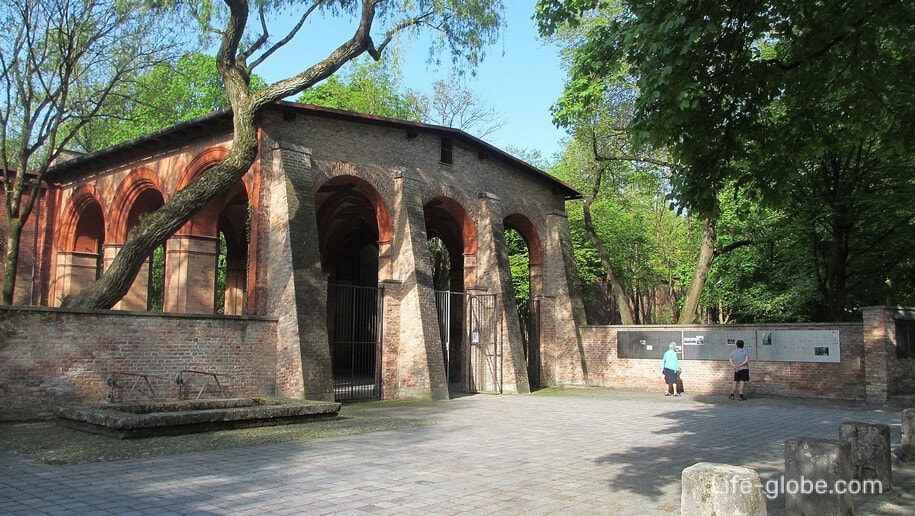
Old Northern Cemetery (Alte Nordfriedhof), built from 1866 and used for burials from 1869 to 1944-1945.
In the post-war years, it was decided not to "open" the old northern cemetery anymore. Many graves were cleared. Of the total capacity of 7,272 graves, only 700 have survived to the present day.
Today, the cemetery is used as a green area (a small park) and as a part of piety towards the people buried here long ago.
Benches have been installed in the park, and instead of a sanctuary, there is now a playground separated from the rest of the cemetery. Next to the children's playground, there is a ball court and places for playing chess (the western edge of the cemetery).
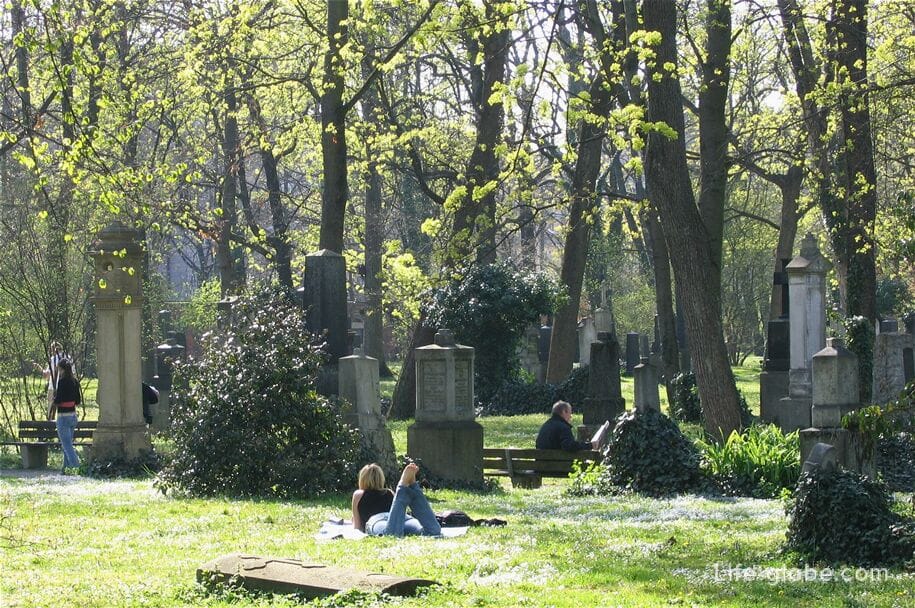
All accommodation options in Munich, including near certain attractions and in the city center, can be viewed and booked here